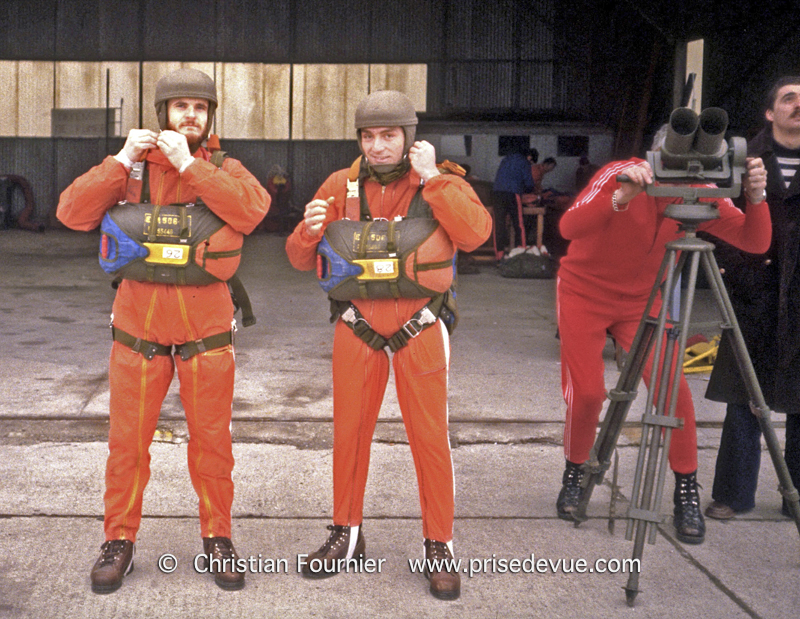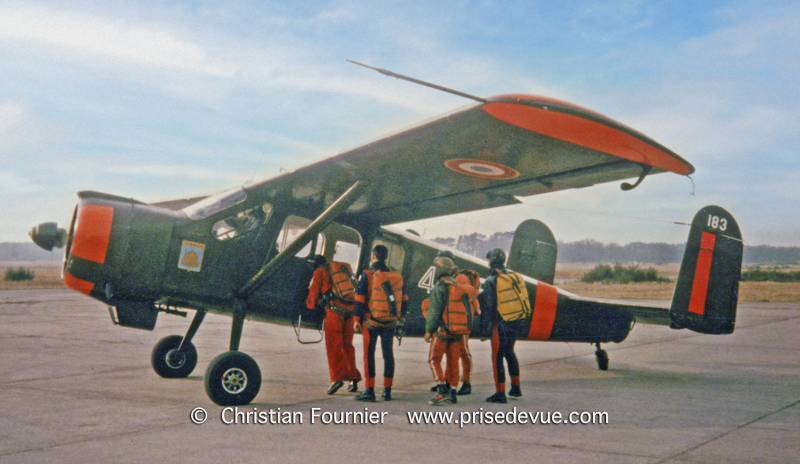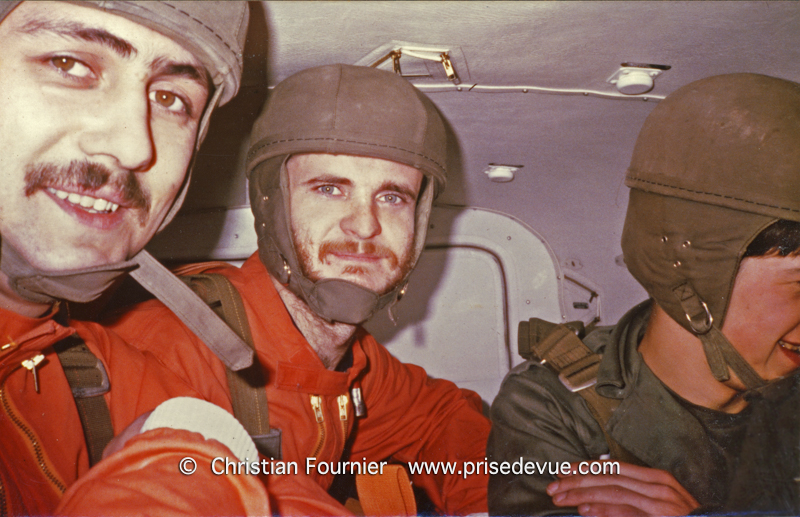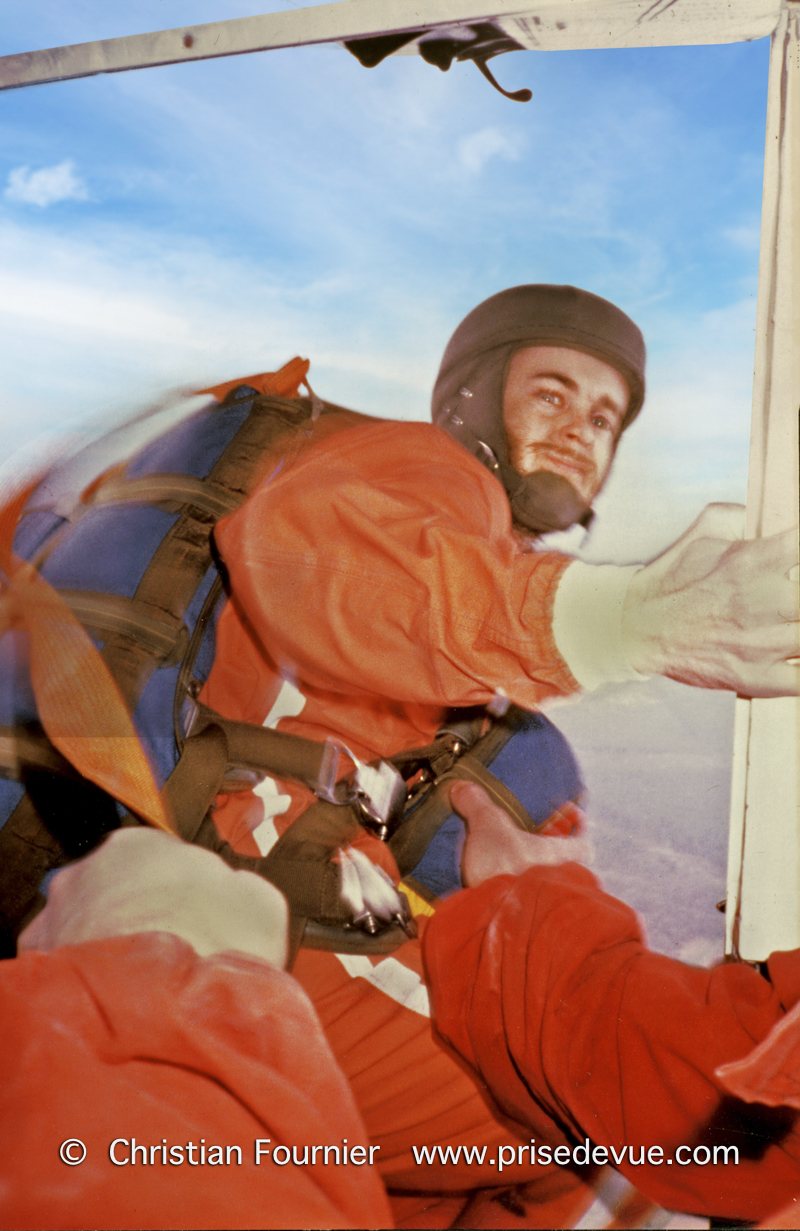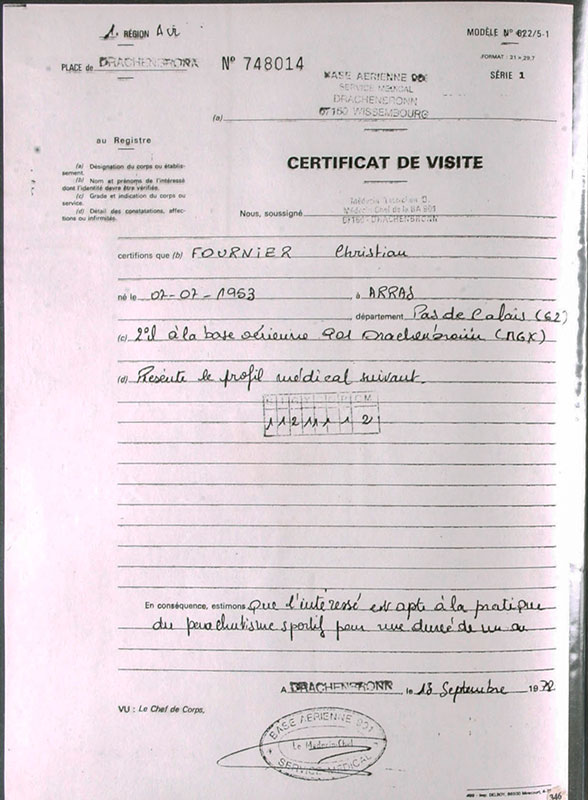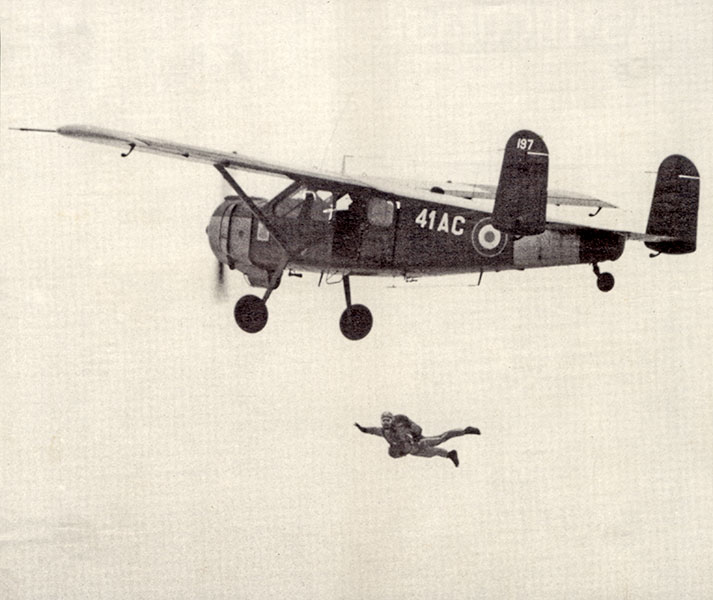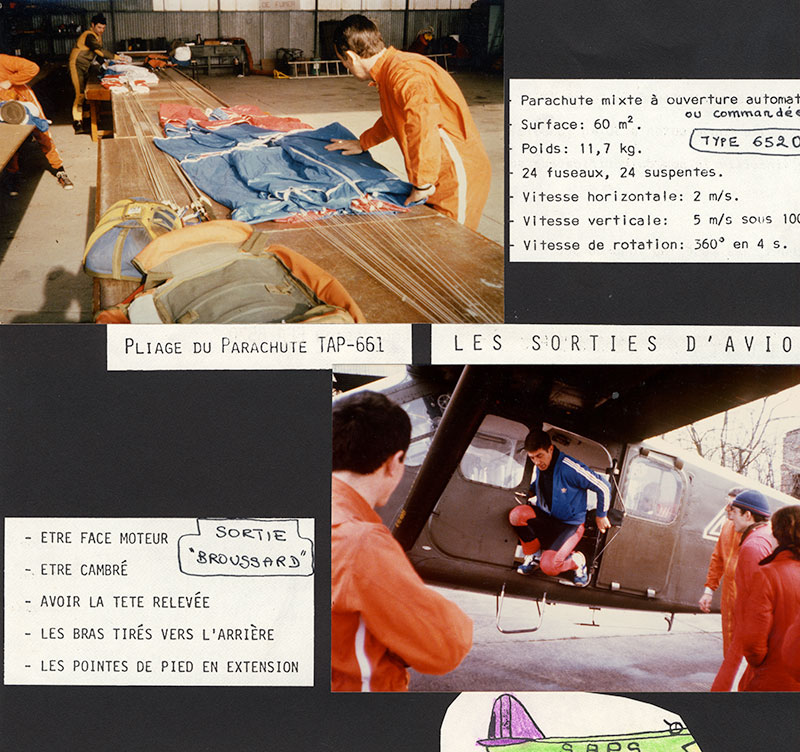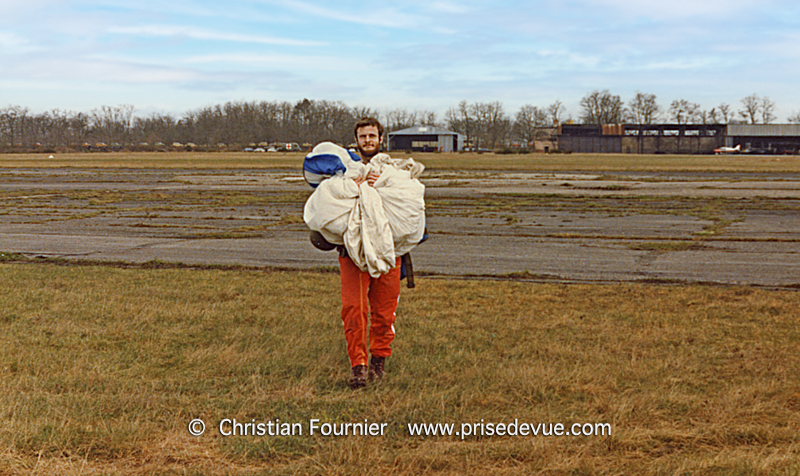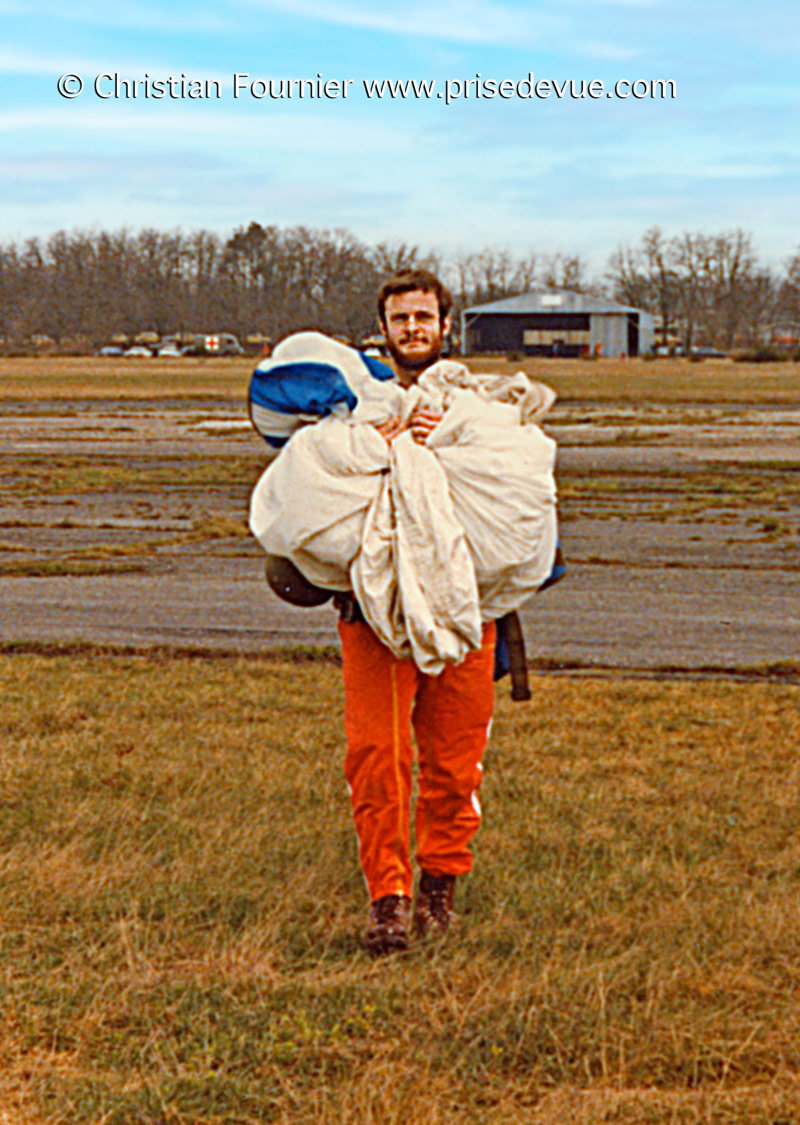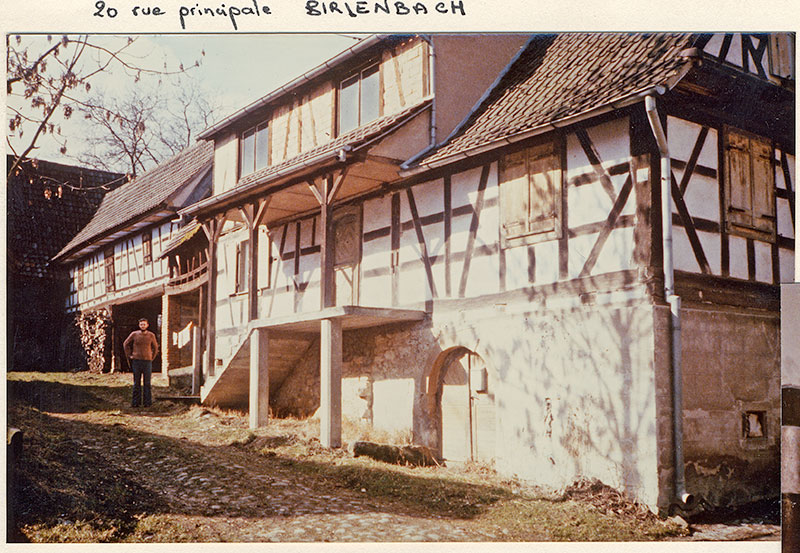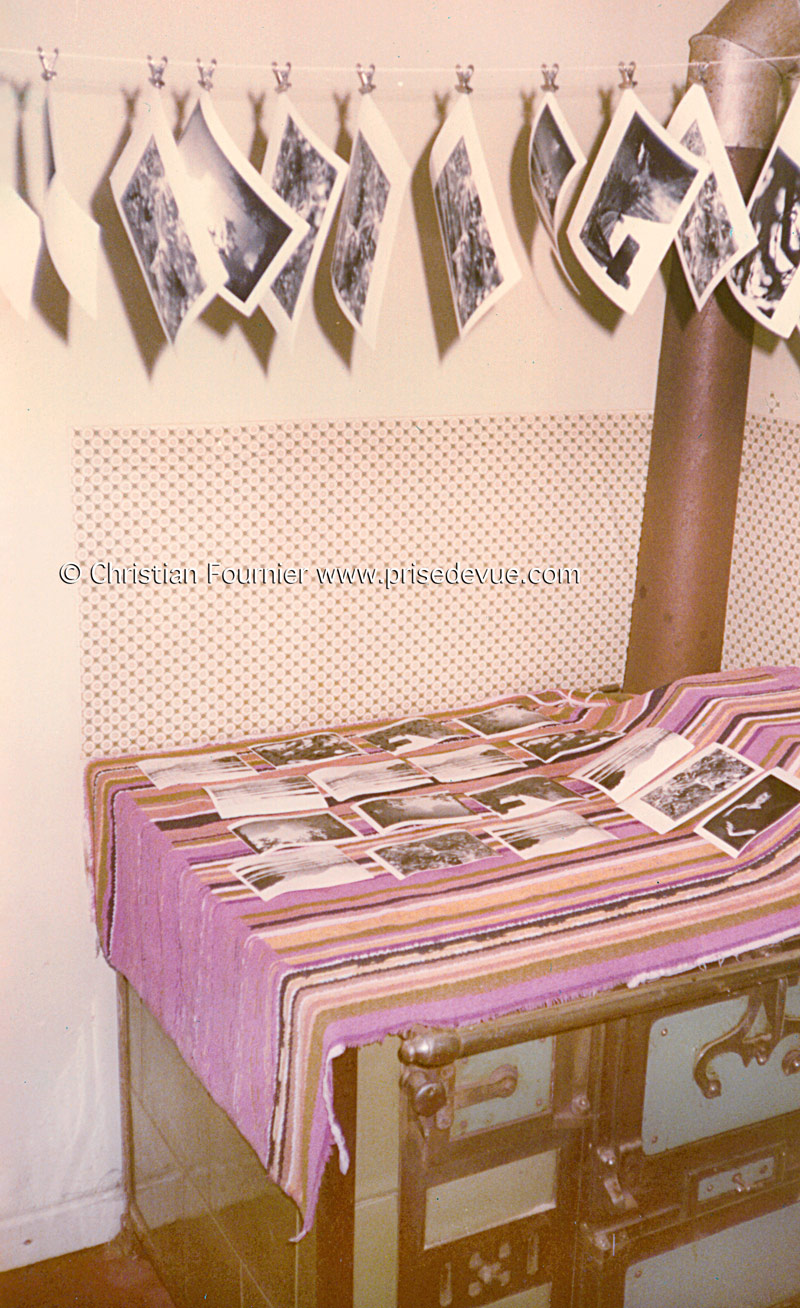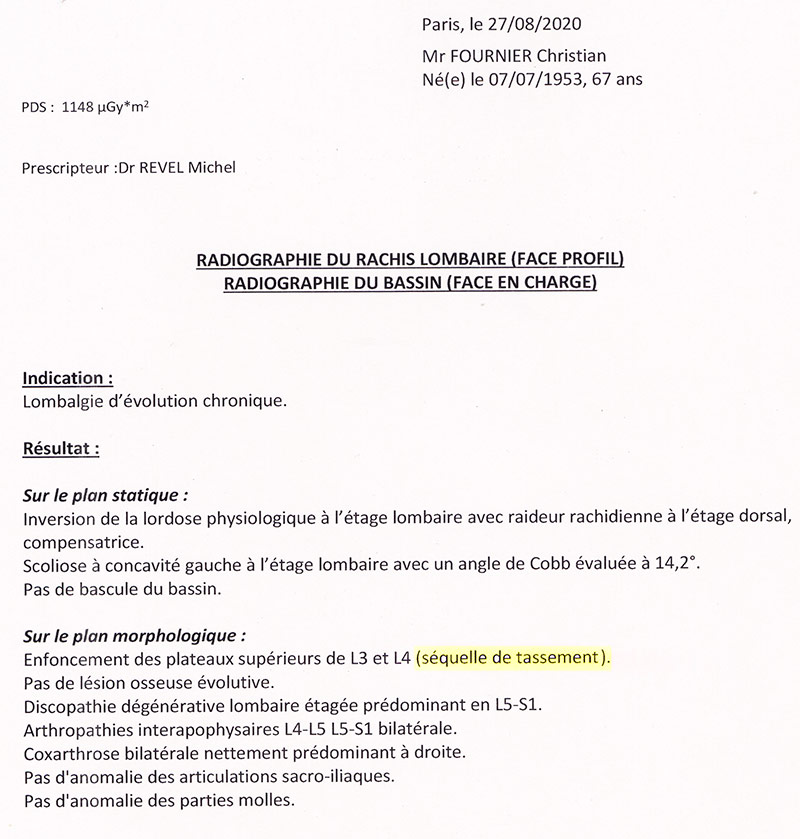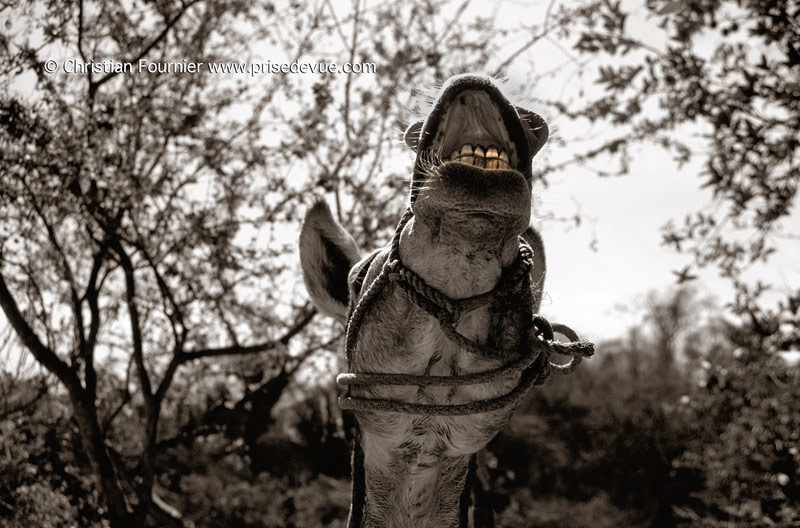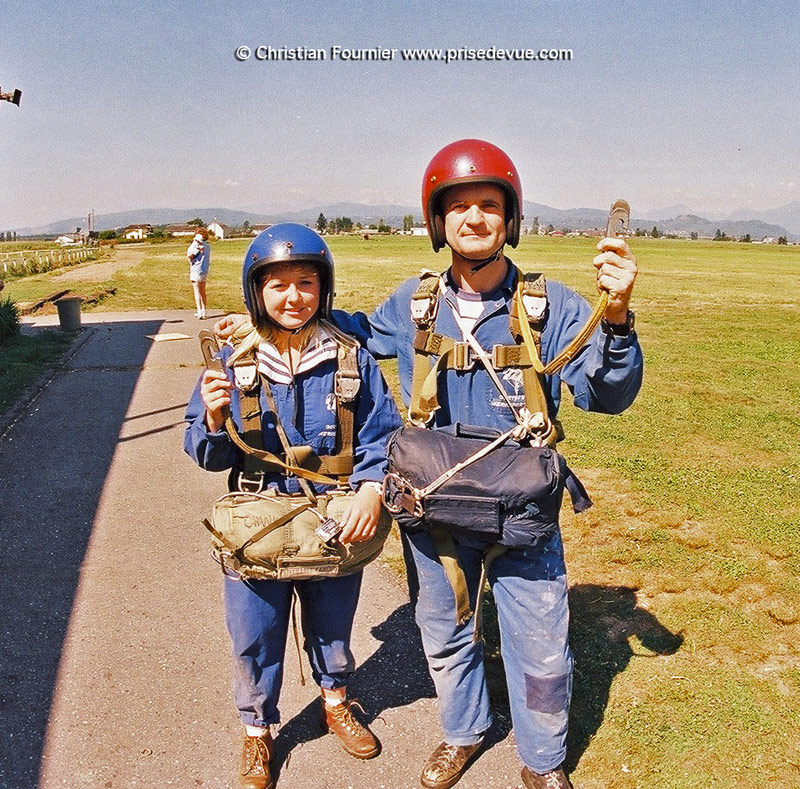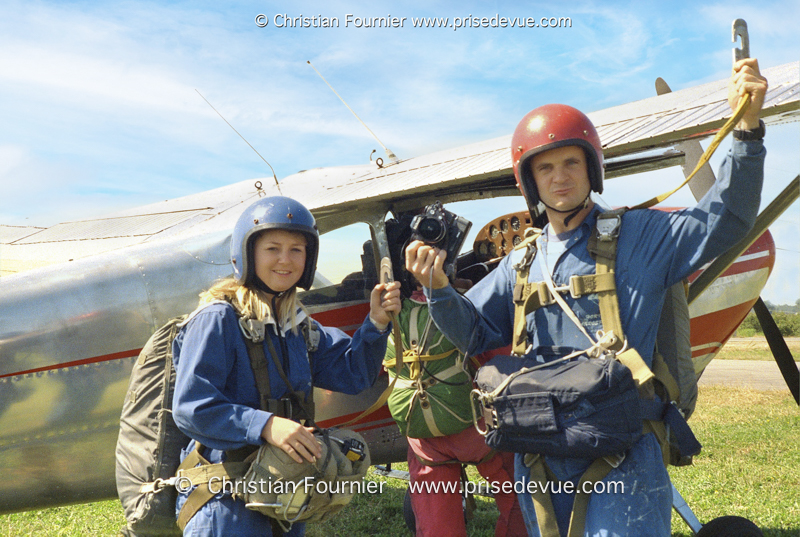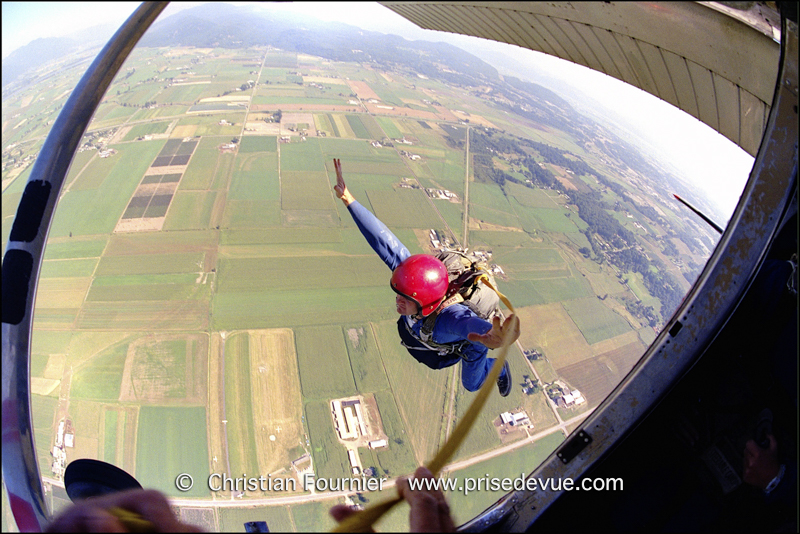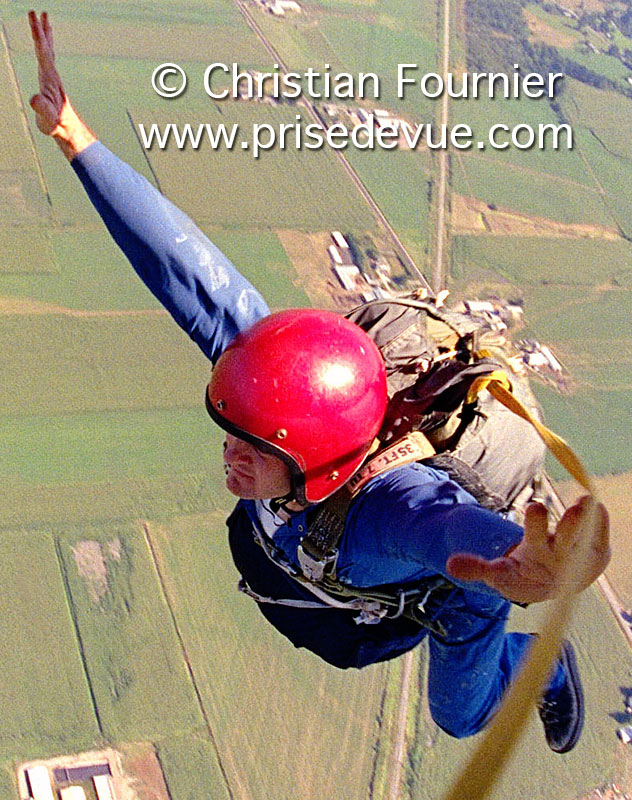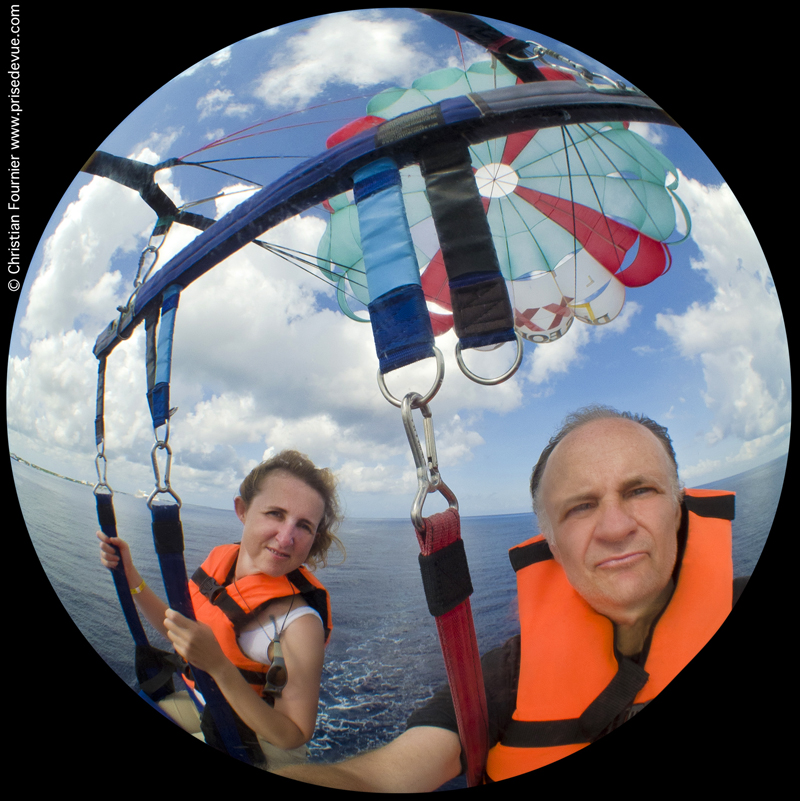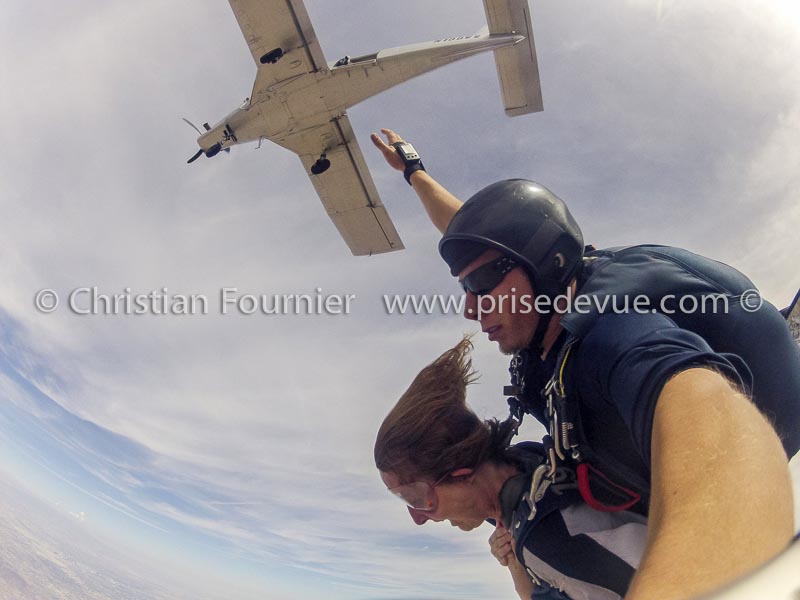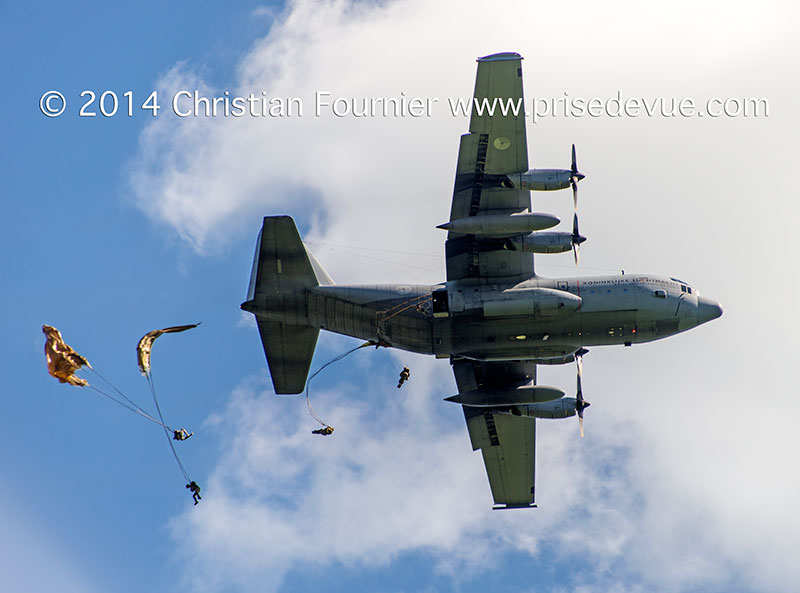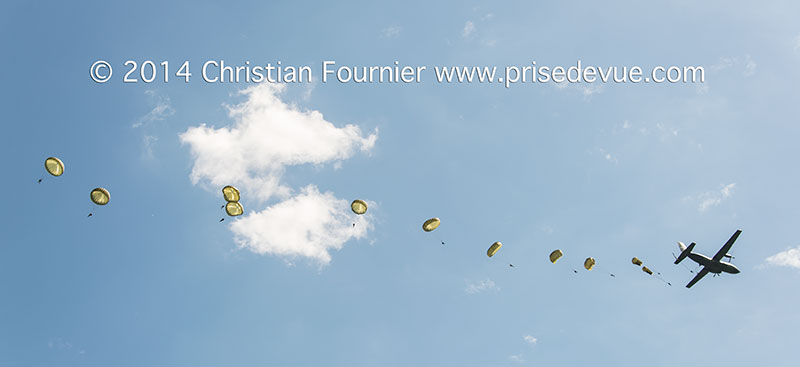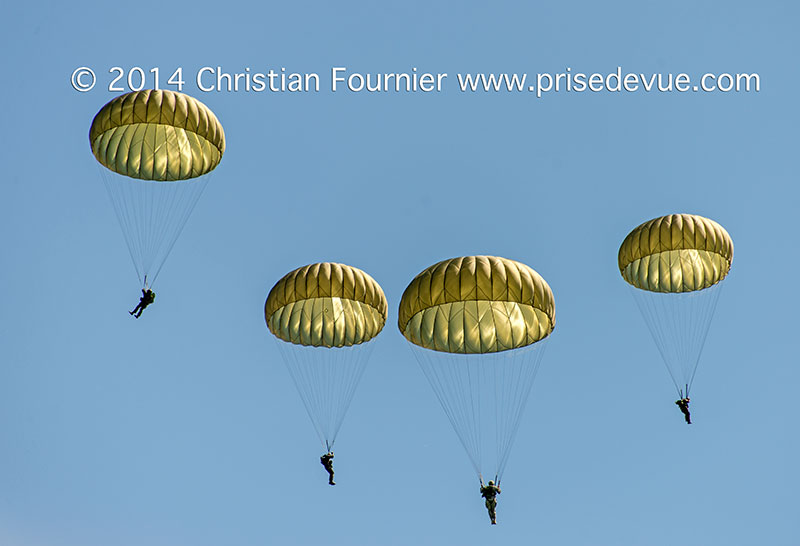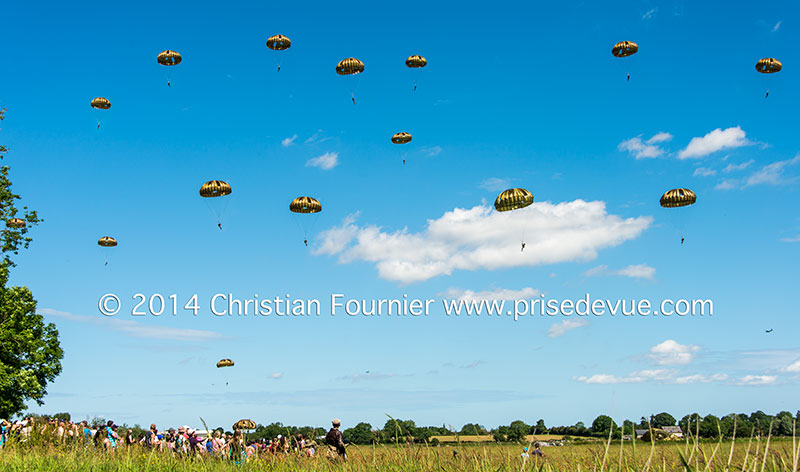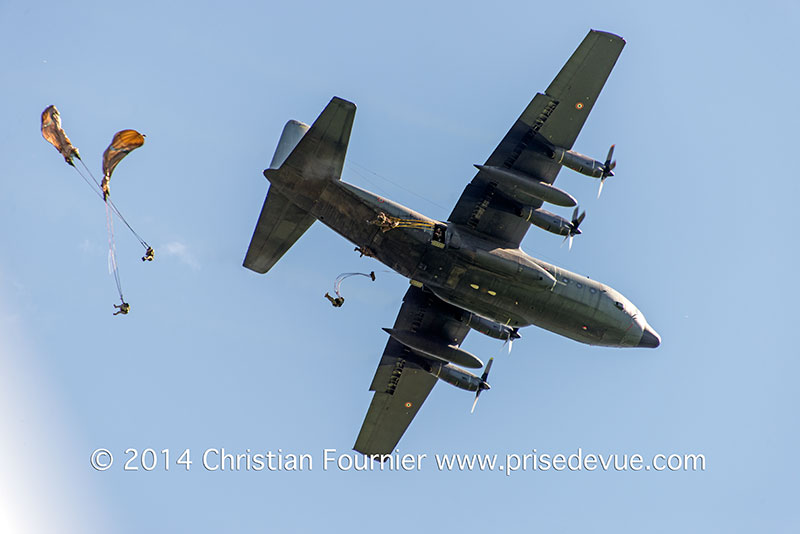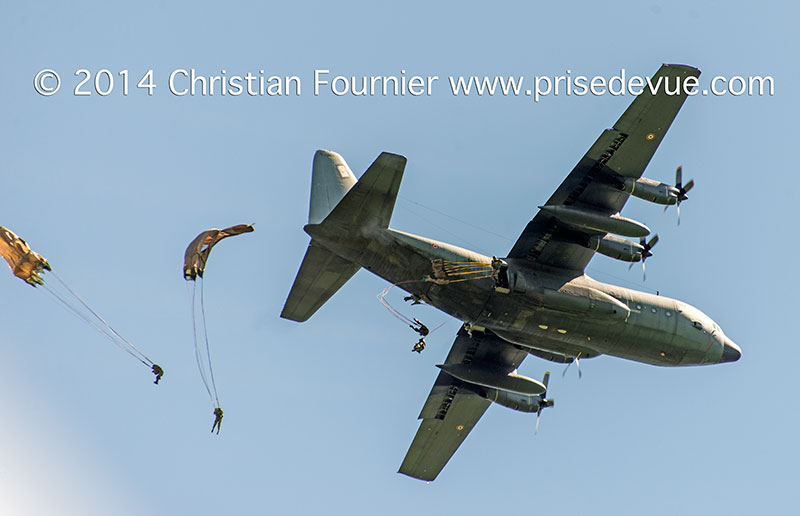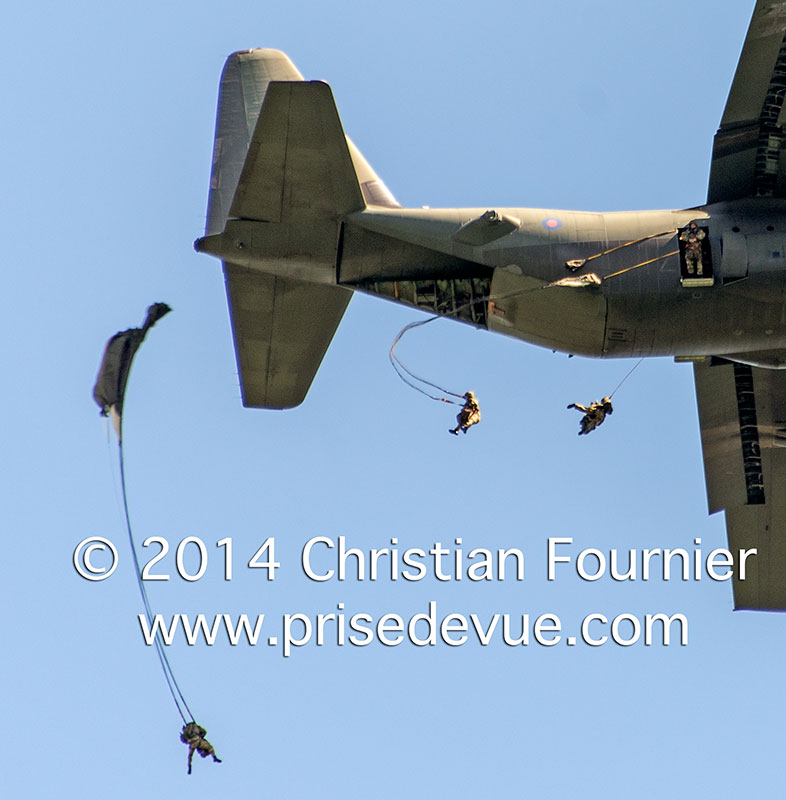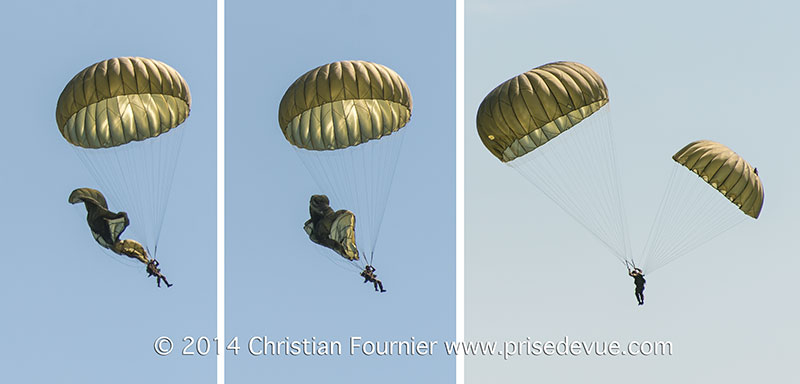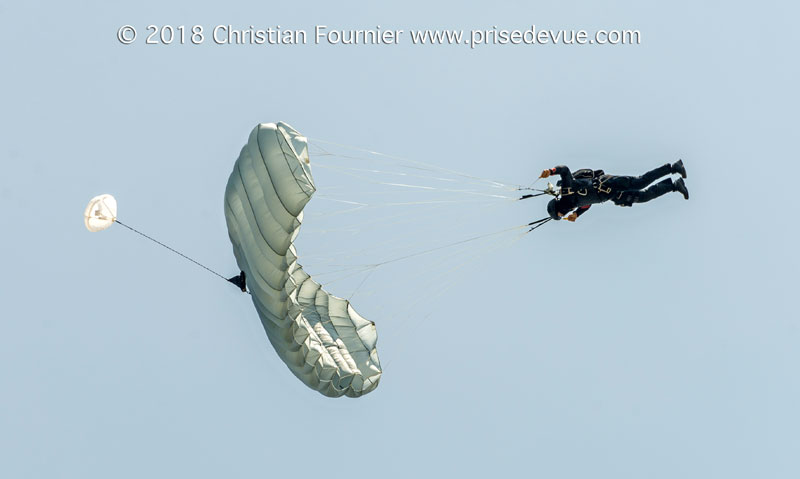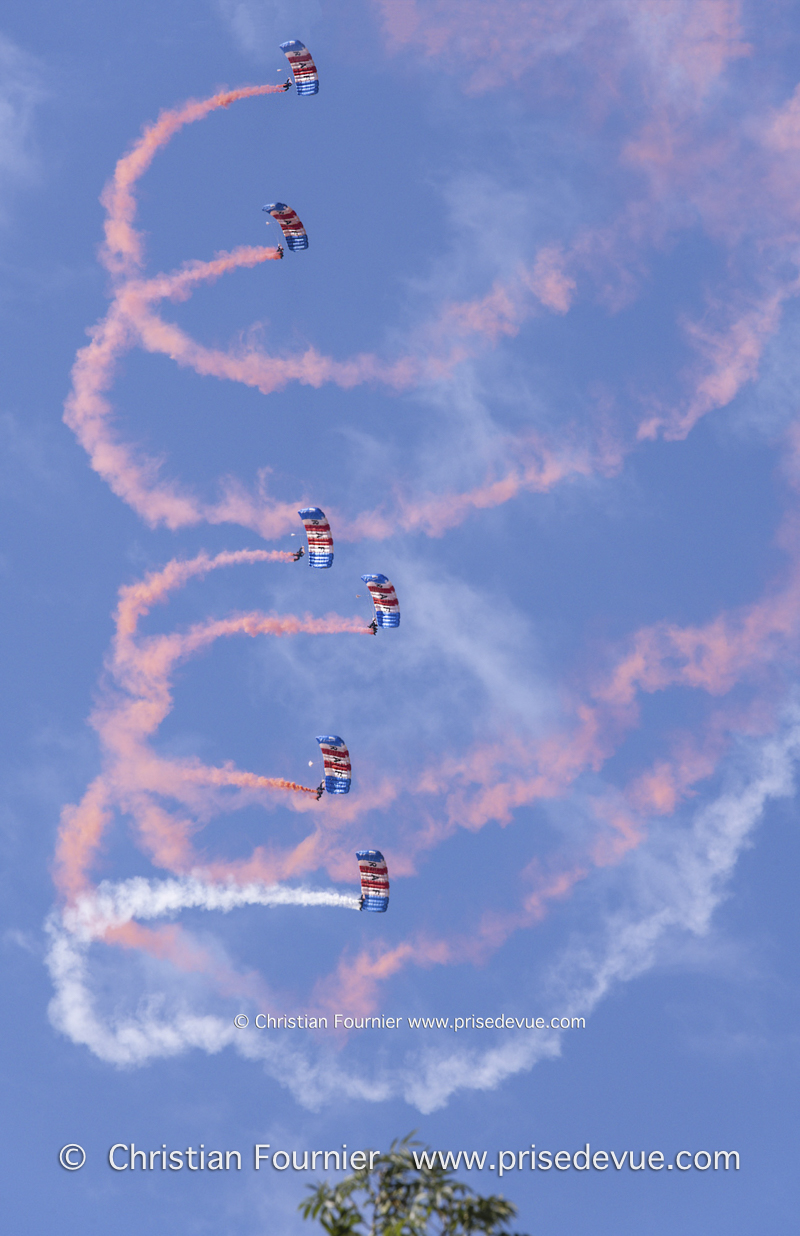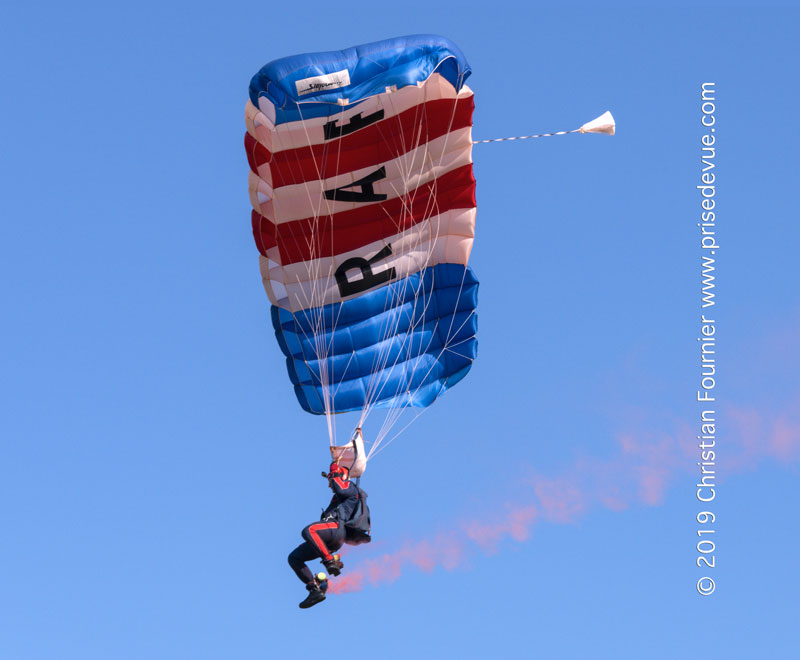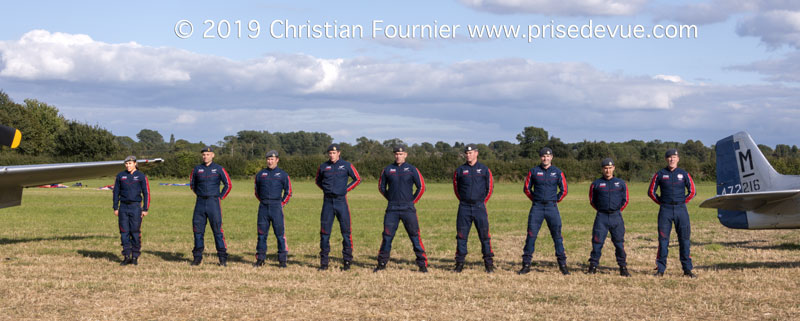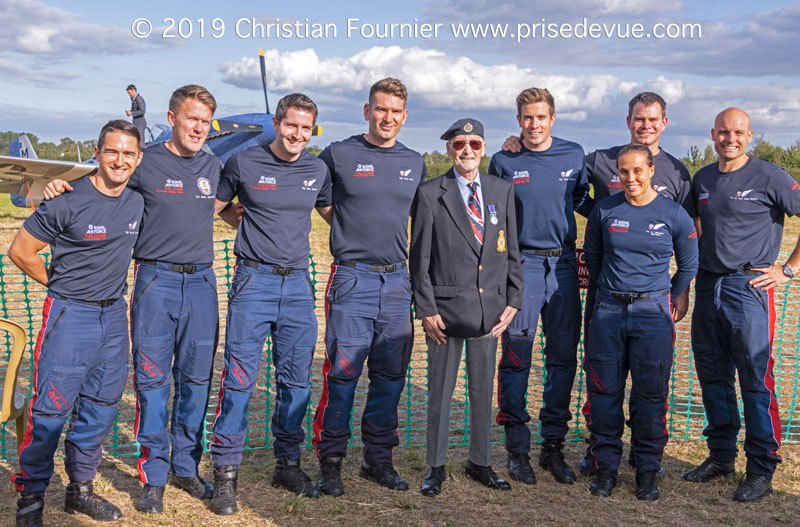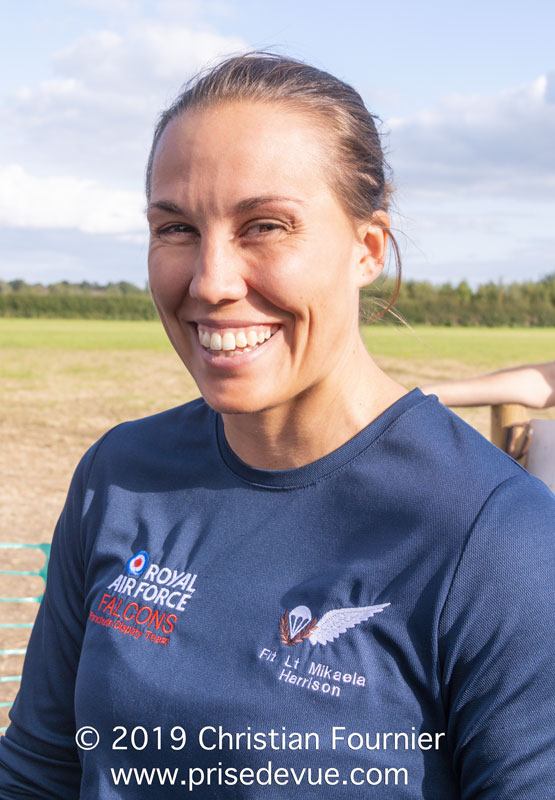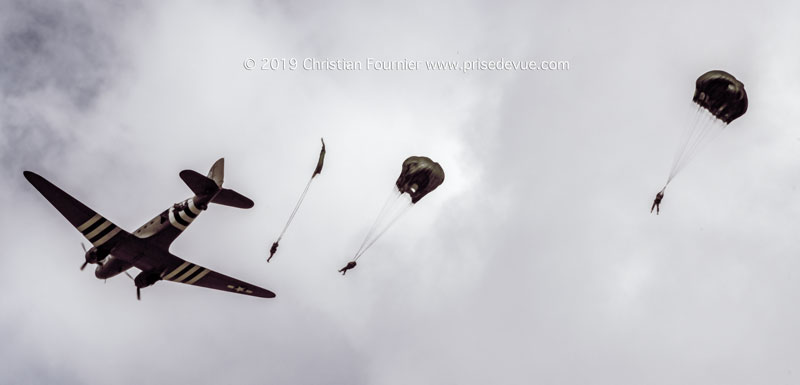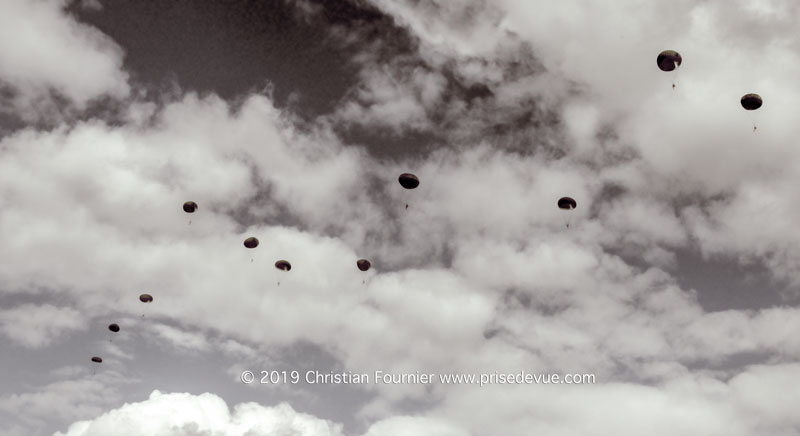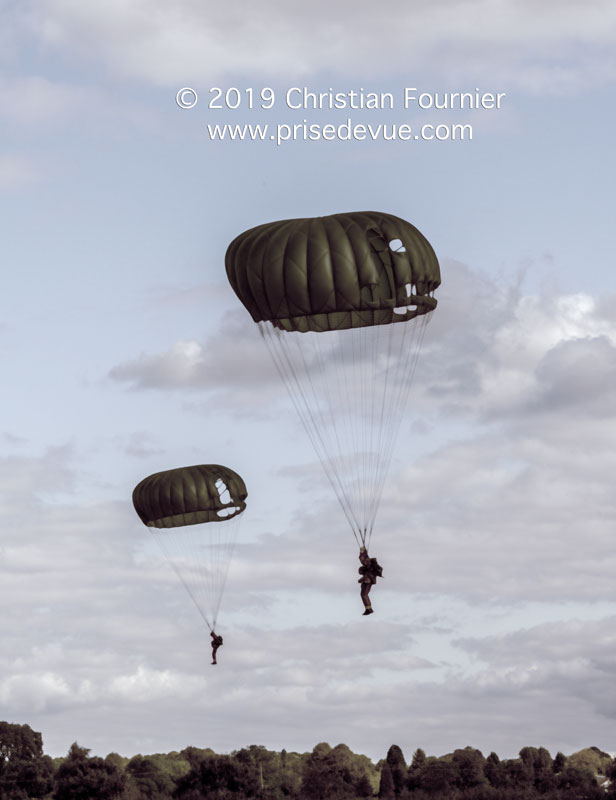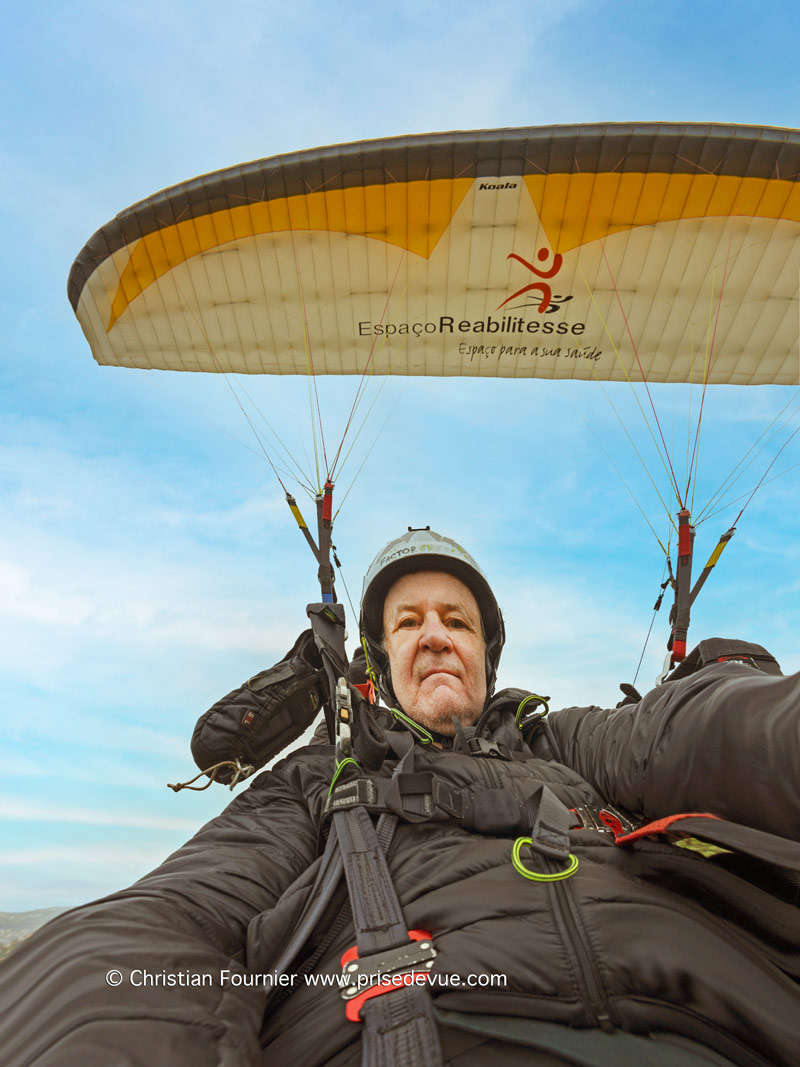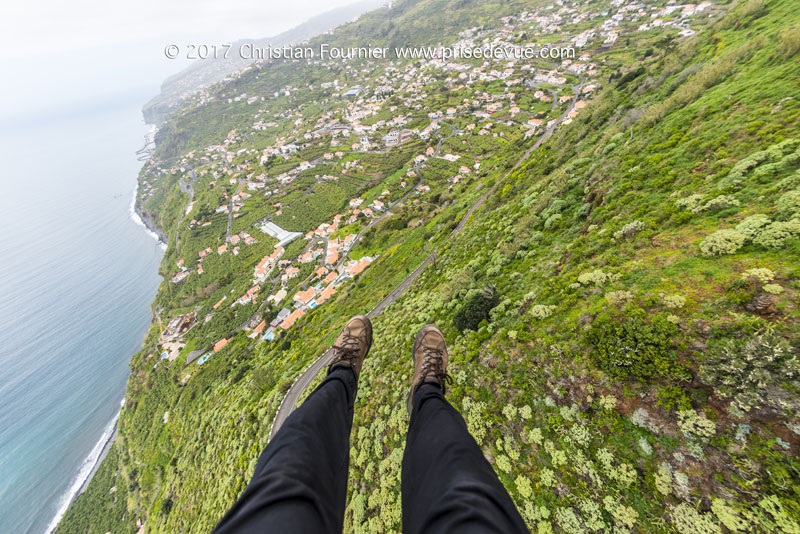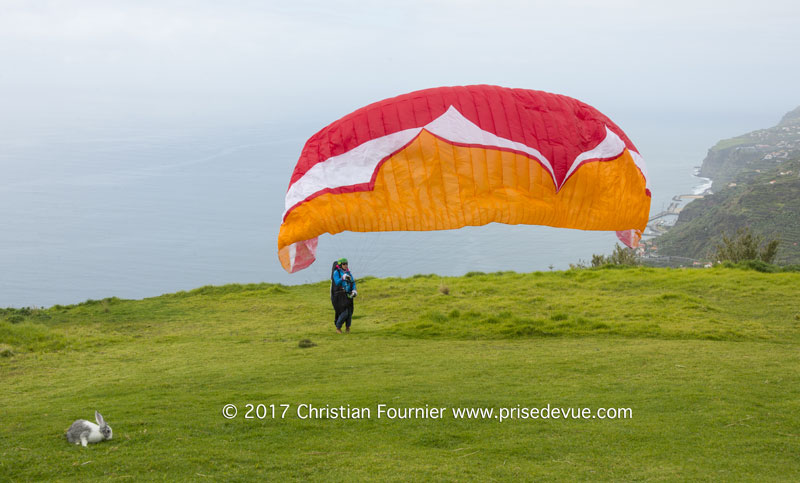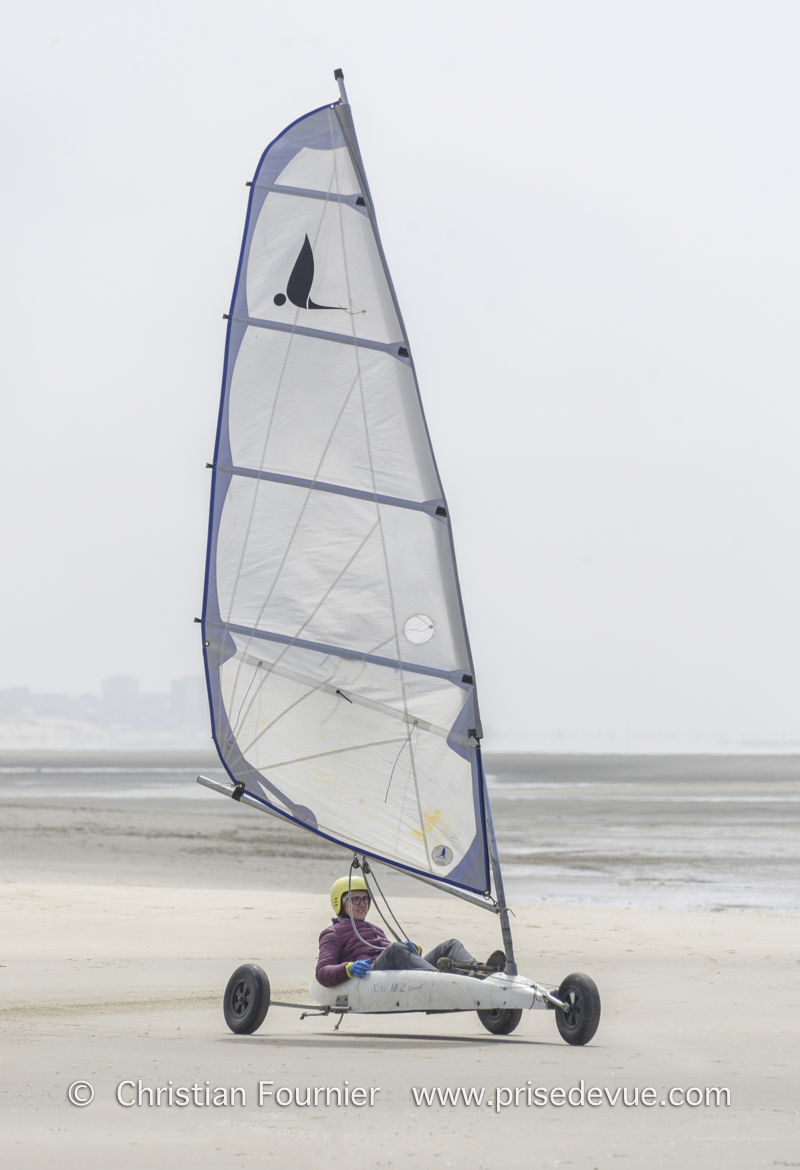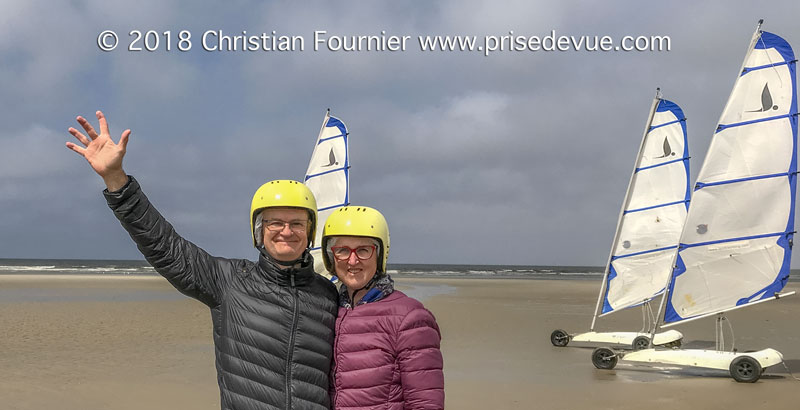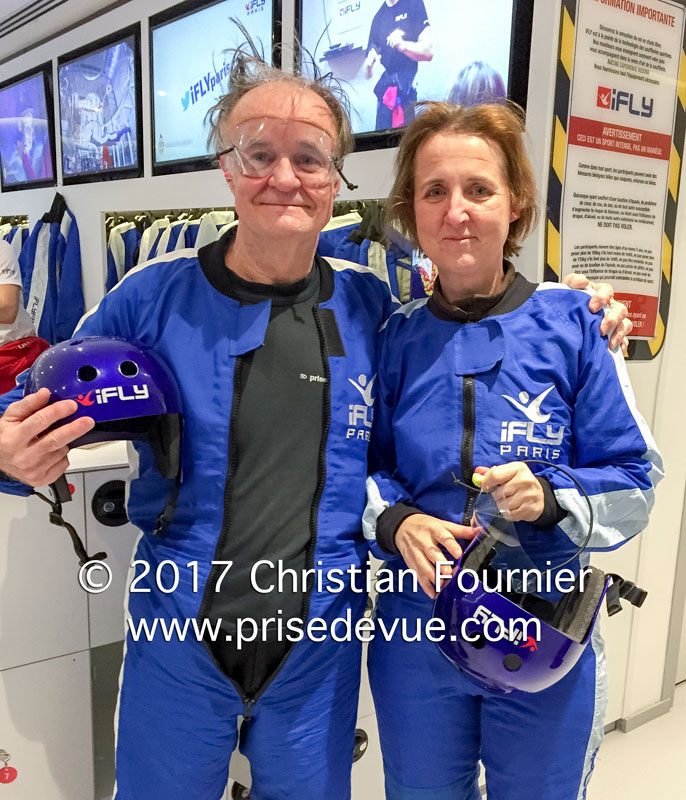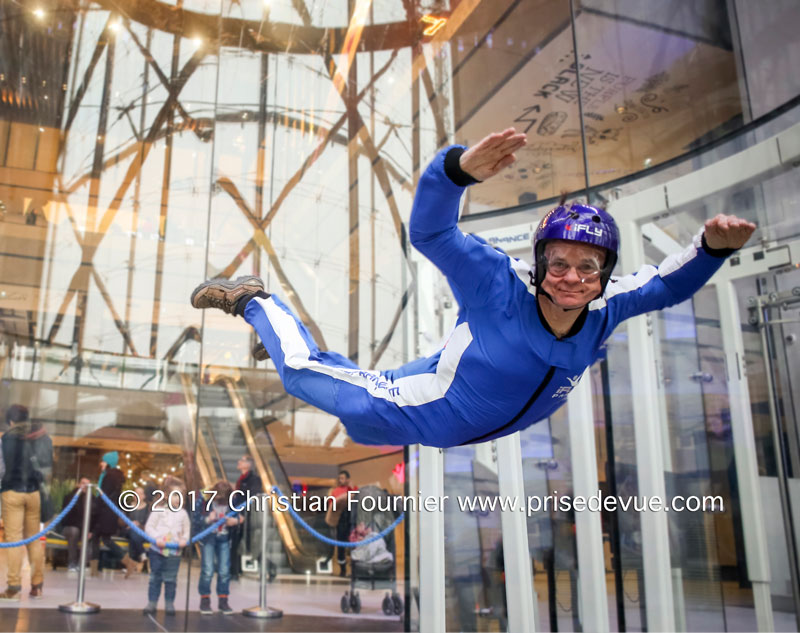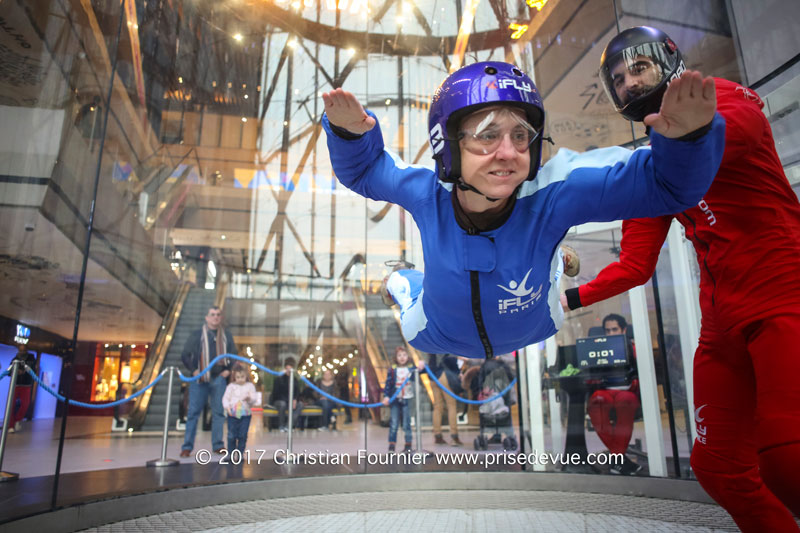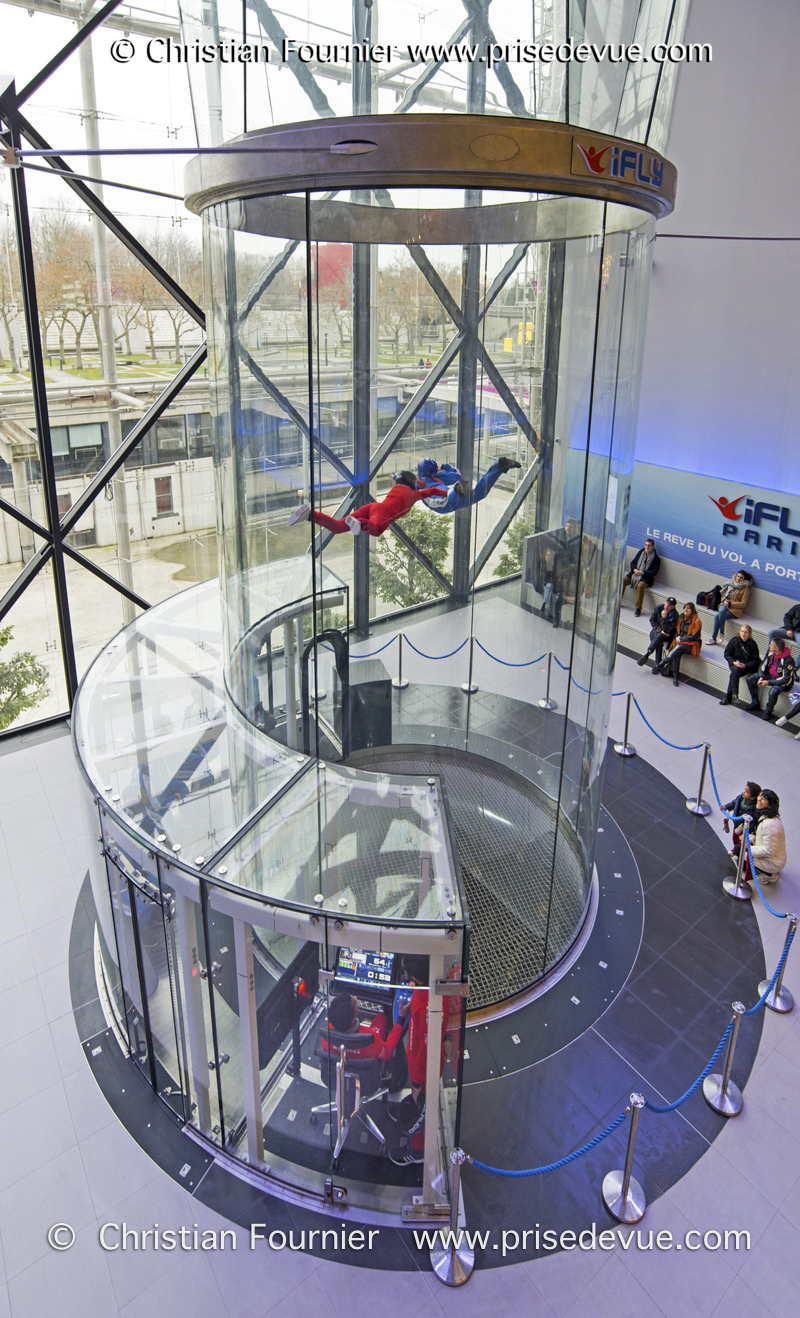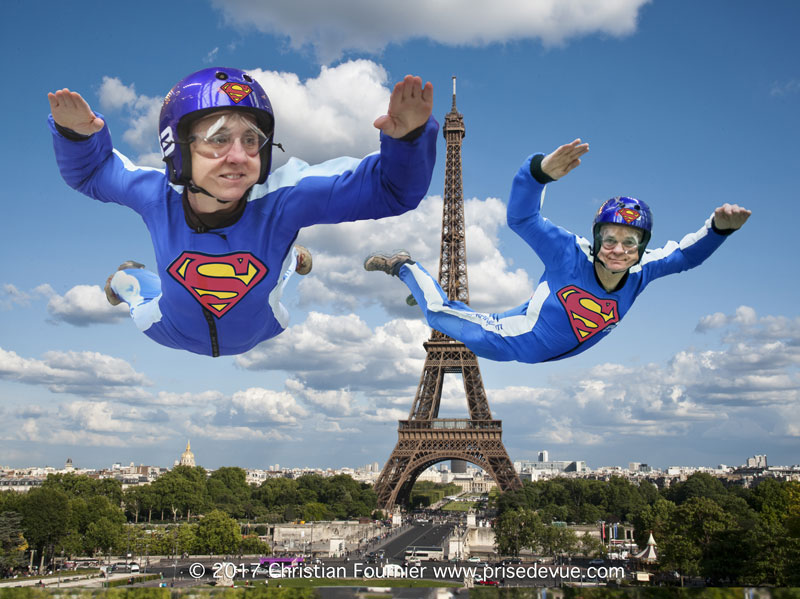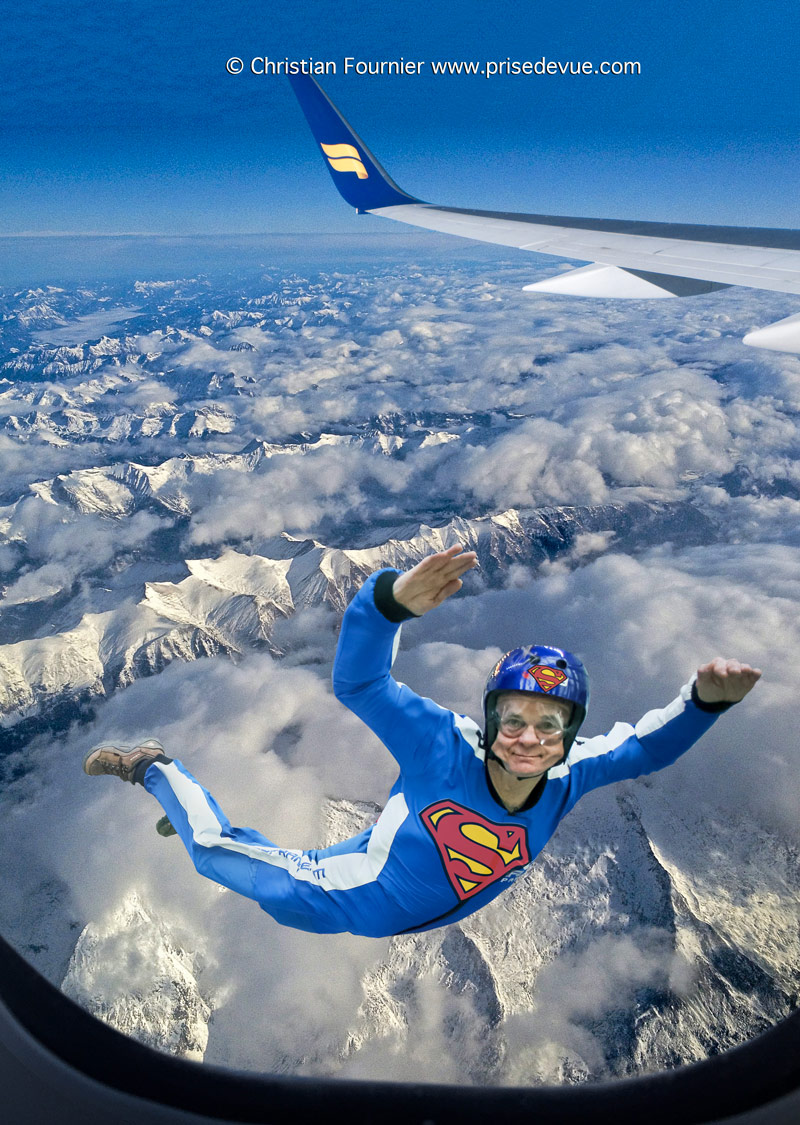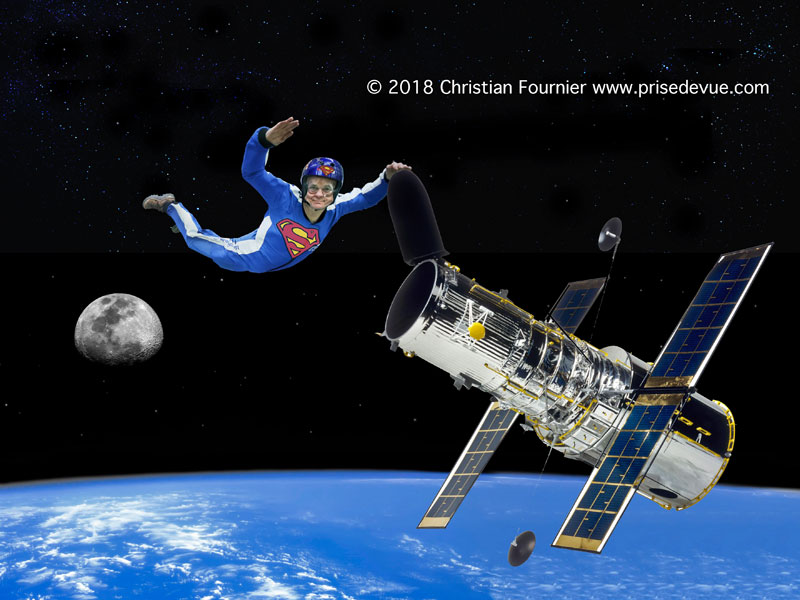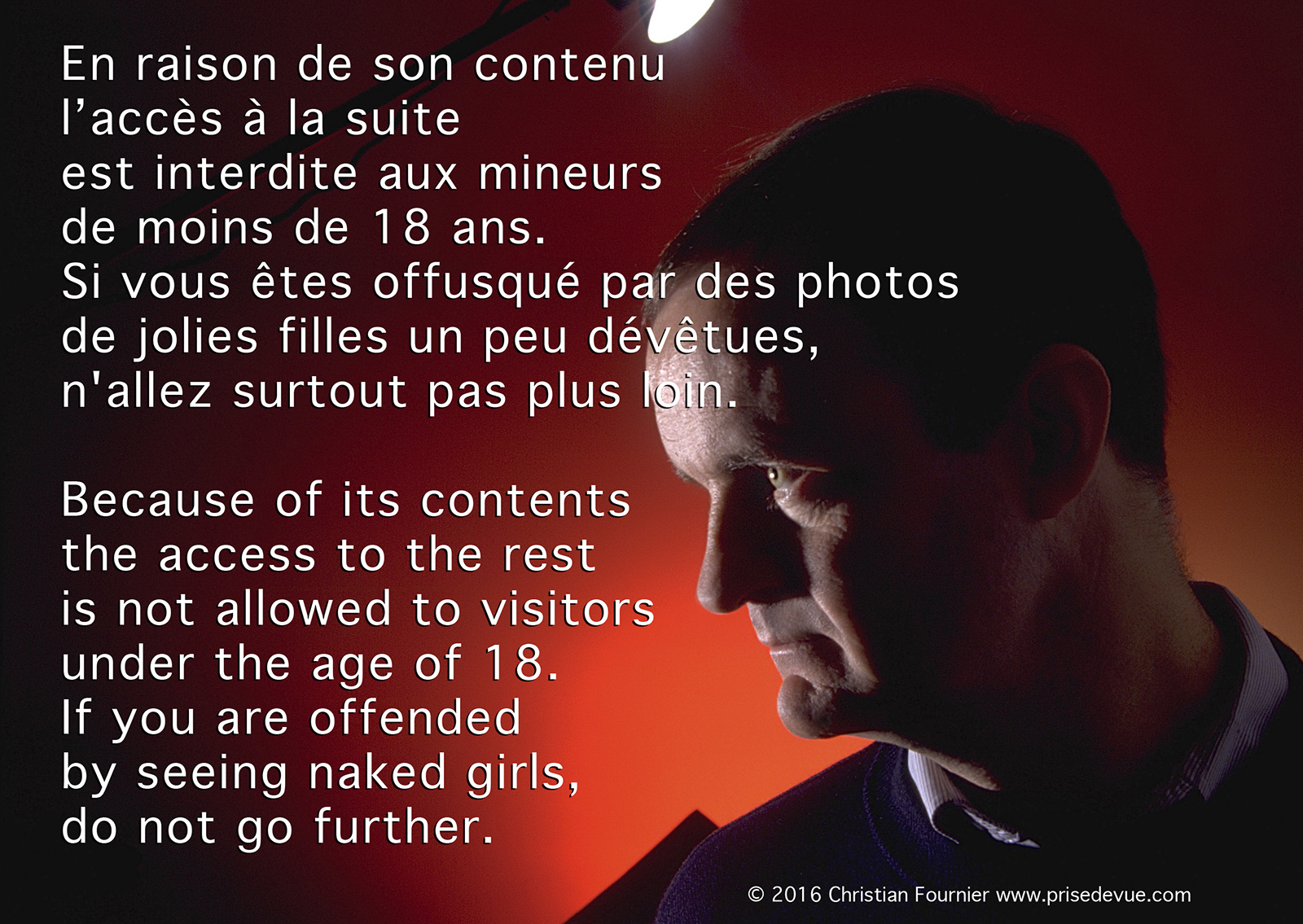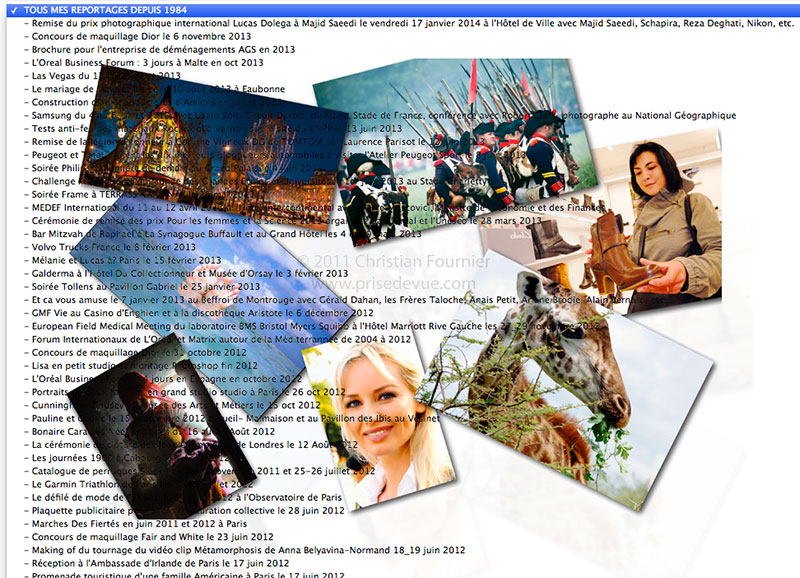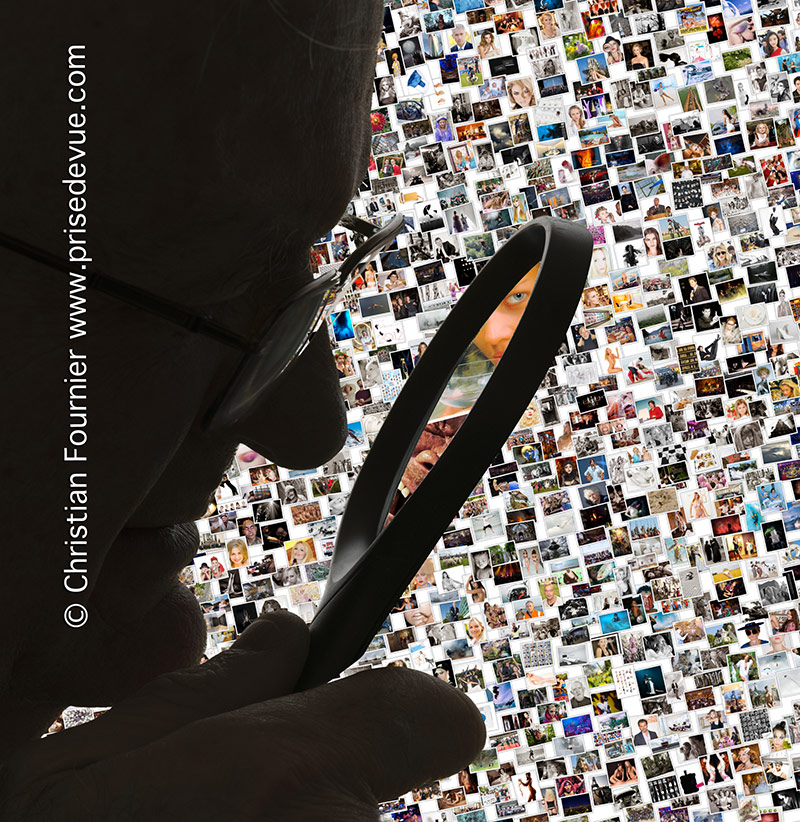In the beginning, I jumped like everyone and like all the equipment, in TAPs (airborne troops). The parachute, a simple half-sphere, could not be steered in the air and opened automatically (we said “en commandé”, controlled) because the static line which pulled the parachutes open was attached to the Saint Andrew’s cross on the plane. Everyone jumped out at the same time, all from one big plane, at a point chosen in the plane by its width, after a first pre-test with a mini-parachute. Everyone landed more or less in the same spot. As we jumped with our guns, we had to throw them away from us, 5 metres before landing, to avoid breaking a leg on it. We attached it with a string to keep from damaging or losing it. Then, as I was good at it, I was recruited into the base’s sports team and we jumped with wings, parachutes with a slit that let you steer. And no gun. Cool. We practiced precision landing (landing with your right foot on a handkerchief bolted to the ground). When we jumped out of the (small, this time) plane, the field we were landing in rather resembled a handkerchief itself. After 50 successful automatic jumps, while pretending to open the parachute by ourselves, we were allowed to skydive. My record is 20 seconds of freefall. Don’t laugh, that’s quite long! To parachute from a small plane (see below on this page) you have to crawl out of the small door to get your feet on the wing strut. At this point you’re facing the propeller with the wind raging at you face-on. To avoid twisting and wrapping the rope around your neck, you have to jump in a crouching position. Then, you fall. Really. At this point what you need to do is -- slowly and in perfect symmetry, if not, you spin – bring your hands towards your chest to grasp the handle which opens the parachute. Next, you get whacked hard in the back as the parachute unfurls. Then, you can steer your parachute left or right by pulling on the right straps. This isn’t as easy as it sounds, the wind often changes at different altitudes. It goes without saying, the parachutes then weren’t as advanced as the ones now (2004). In freefall, there wasn’t even an automatic parachute deployment feature. So you had to open it. Just don’t lose consciousness!
There was a warrant officer who would never stop yelling at us and would scream at us day in day out. He would openly mock the beginners, “Yeah, you’ll see, when you jump you’re going to shit your pants, you’ll cry, you’ll cry for your Mommy, etc…”. I didn’t let it get to me, I was always ready to jump ahead of him, no hesitation at all, I would throw myself into the air with pleasure (at the time, everyone folder their own parachute, with competent people checking it along the way). This only further enraged him, and he screamed at me even more. He wasn’t really the intellectual type. One day, he had a “hard handle”, his parachute deployment handle wouldn’t readily open because the cables weren’t properly aligned, a mistake made in folding. Watching from the landing strip with binoculars, we saw him plummeting at full speed towards the ground, finally deploying at 300m (at the time, this was the limit with any hope of survival). He was so terrified that he had a nervous reaction, his jaw muscles were blocked and he couldn’t speak (or yell) for a few weeks.
|
Partial eclipse of the Moon, seen from Paris, in my courtyard, in Port Royal, on July 16, 2019.
- 9:30 pm: the Moon rises
- 22:00: the Moon enters the shadow of the Earth and begins to be nibbled
- 23:30: the Moon is nibbled to the maximum. 65% of his disk is in the shadow of the Earth
- 01H00 in the morning: the Moon comes out of the shadow of the Earth. The eclipse is over.
Everything went as planned as always thanks to astronomers. Yet most people prefer astrology to astronomy. Yet it is clear that astrology and its horoscopes are bullshit. Yet, there is a daily "horoscope" section in every newspaper in the world, but never a daily section on astronomy.
- "It is not a sign of good mental health to be well adapted to a sick society": Jiddu Krishnamurti.
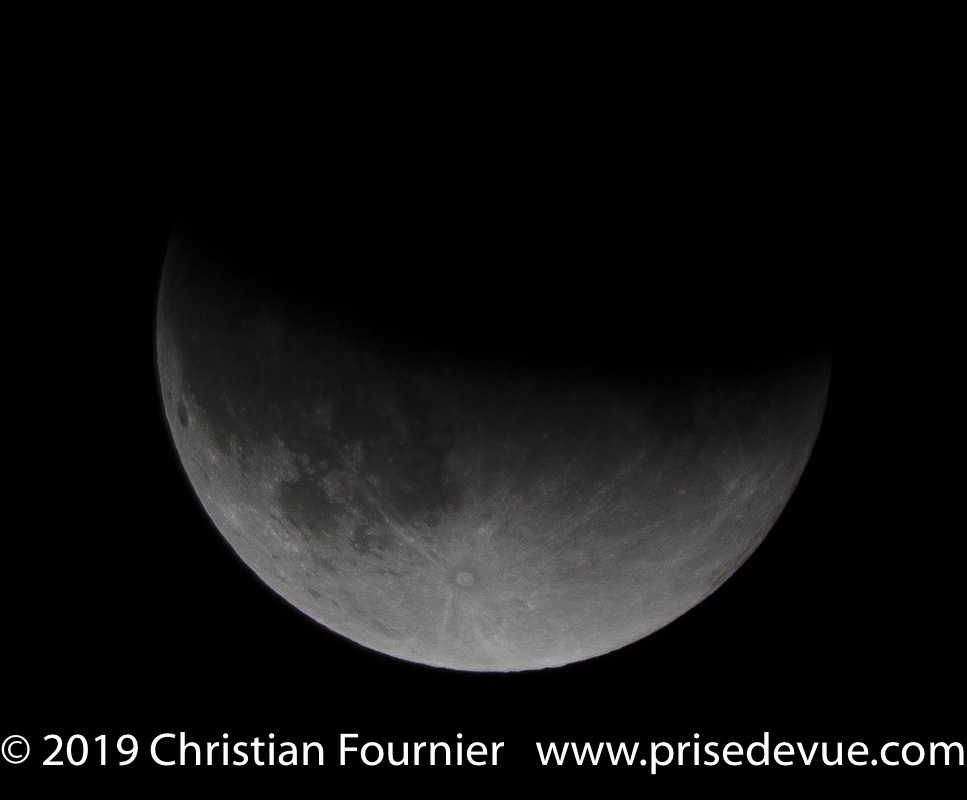
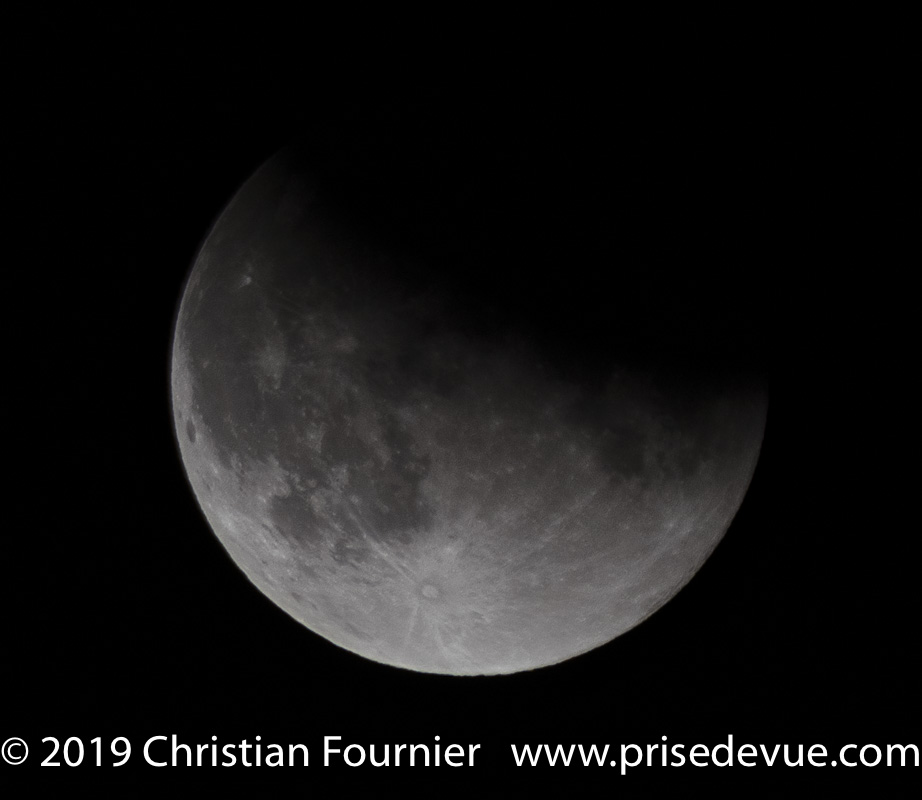
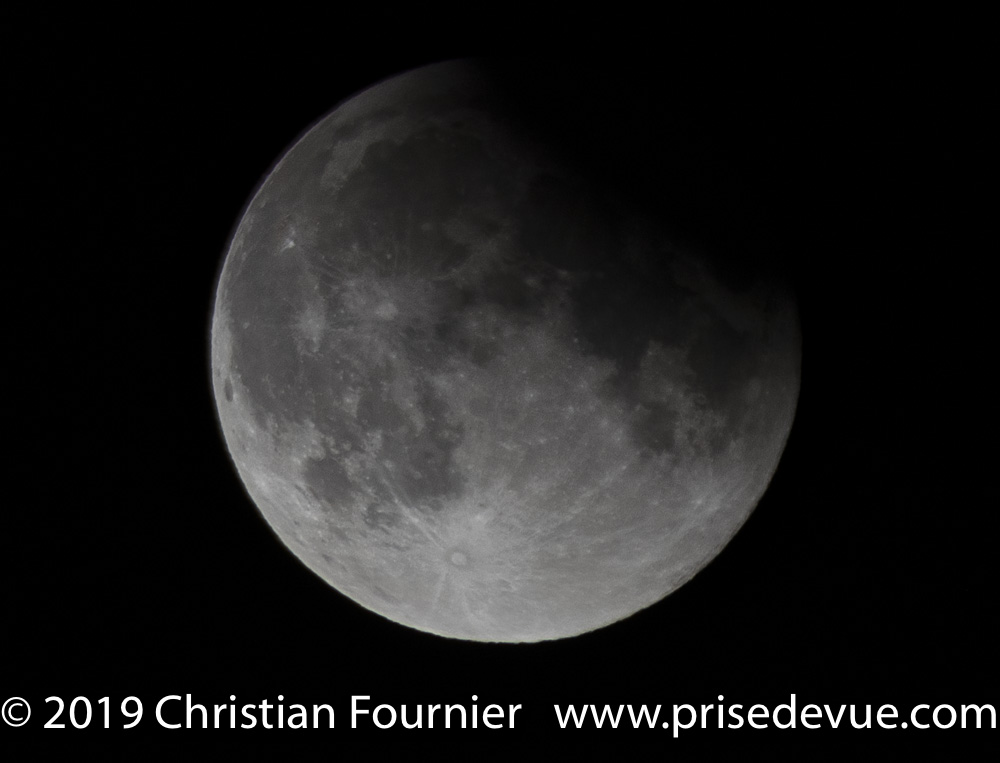
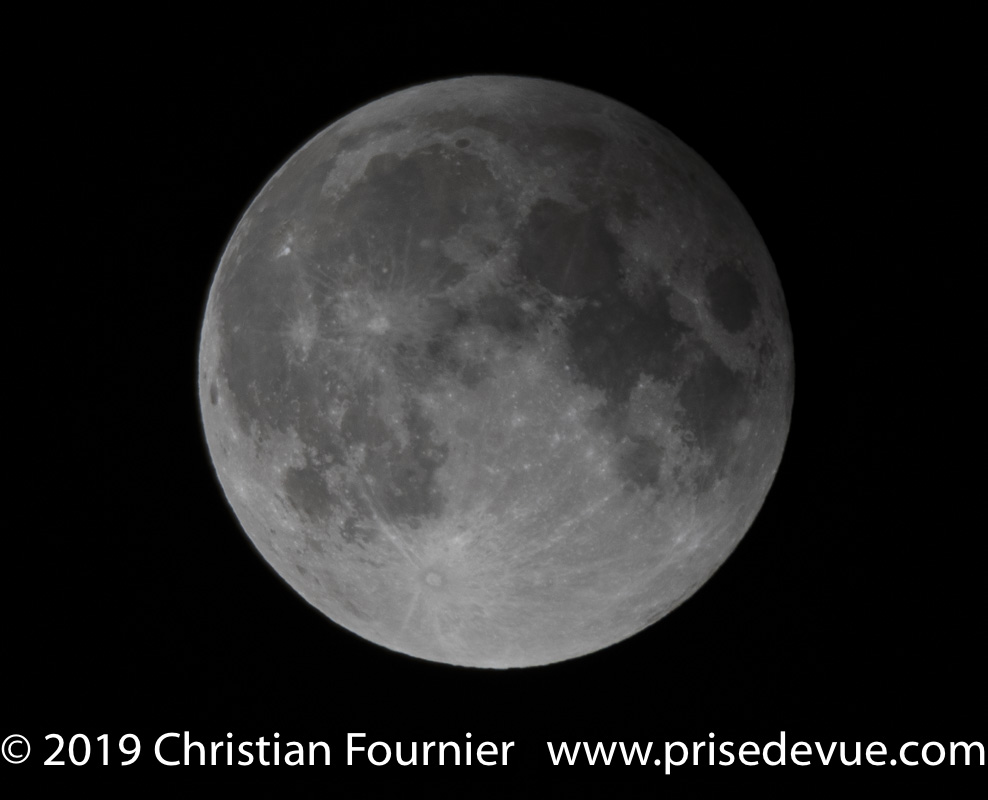
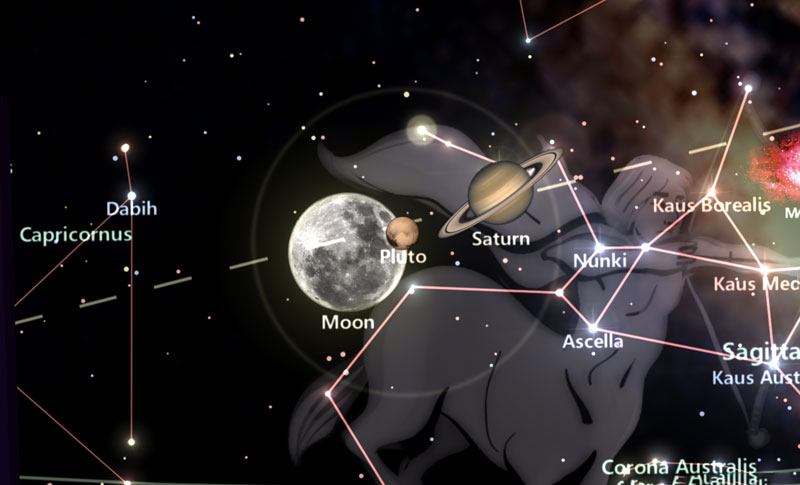
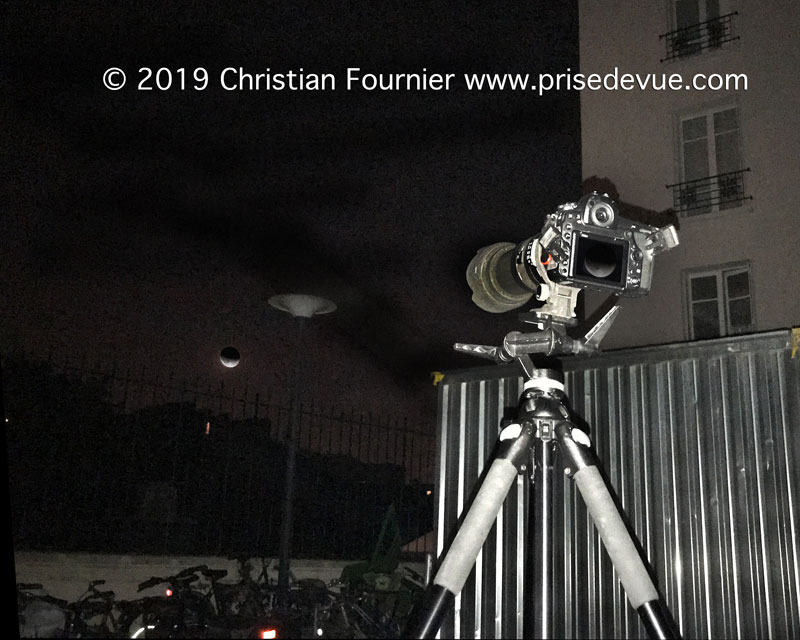
The flying saucer is a street light
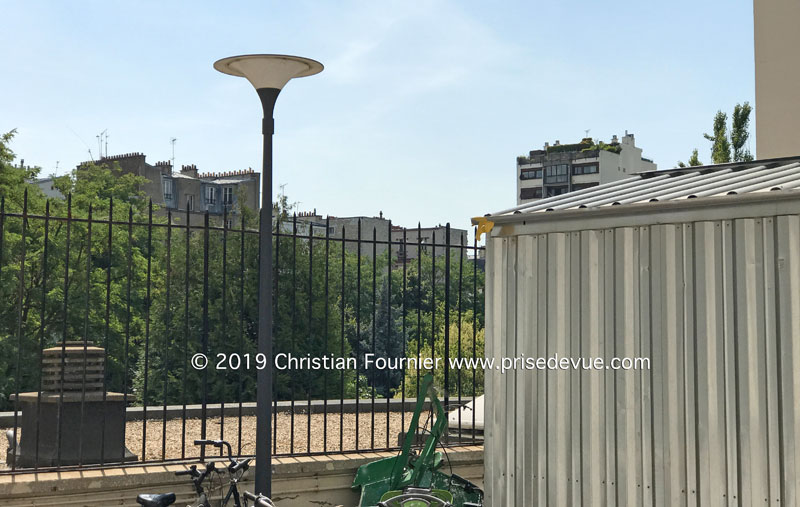
From Shannon Templeton, friend since 1987.
Hello Christian!
Those are gorgeous pictures of the Moon, I love how you included the night version of the "UFO" and then the day version showing it is a lamp. That is wonderful!
I have stopped using Facebook, it was taking up too much of my time. I also think it is a little bit awful and actively screwed up the elections for the US helping put Trump in office. But it does have its good side, such as getting to see your pictures, and I really miss that. So I may start using it again, who knows? I am so happy you emailed me when you didn't see me on Facebook. Thank you for doing that!
I am involved with a very exciting project now which is taking up my time - NASA's TESS planet hunter space telescope. The observatory I work with got accepted into their "follow up" program which means I'm part of the group of astronomers who get to see the data first. The TESS cameras have huge pixels that can have more than one star in each pixel, so when an exoplanet crosses in front of its star (from our point of view), there is a small dip in the light. The TESS cameras will detect the small dimming which triggers an alert that there may be an exoplanet somewhere in the sky area covered by the huge pixel. We get a list of those coordinates in the sky and then it's our job to follow up using our ground based telescope to see which star is dimming in brightness. I hope I have explained it well, it is so exciting to be involved with this work! What could be more fun than finding planets outside our solar system?
This gives a good overview of what TESS does: https://www.nasa.gov/content/about-tess
The Transiting Exoplanet Survey Satellite (TESS) is the next step in the search for planets outside of our solar system, including those that could support life. The mission will find exoplanets that periodically block part of the light from their host stars, events called transits. TESS will survey 200,000 of the brightest stars near the sun to search for transiting exoplanets. TESS launched on April 18, 2018, aboard a SpaceX Falcon 9 rocket.
TESS scientists expect the mission will catalog thousands of planet candidates and vastly increase the current number of known exoplanets. Of these, approximately 300 are expected to be Earth-sized and super-Earth-sized exoplanets, which are worlds no larger than twice the size of Earth. TESS will find the most promising exoplanets orbiting our nearest and brightest stars, giving future researchers a rich set of new targets for more comprehensive follow-up studies.
And here is more about the Follow Up program if you want to see examples of the data. I know you would love the math. https://heasarc.gsfc.nasa.gov/docs/tess/followup.html
I hope you are doing well, it is always wonderful to hear from you.
Shannon
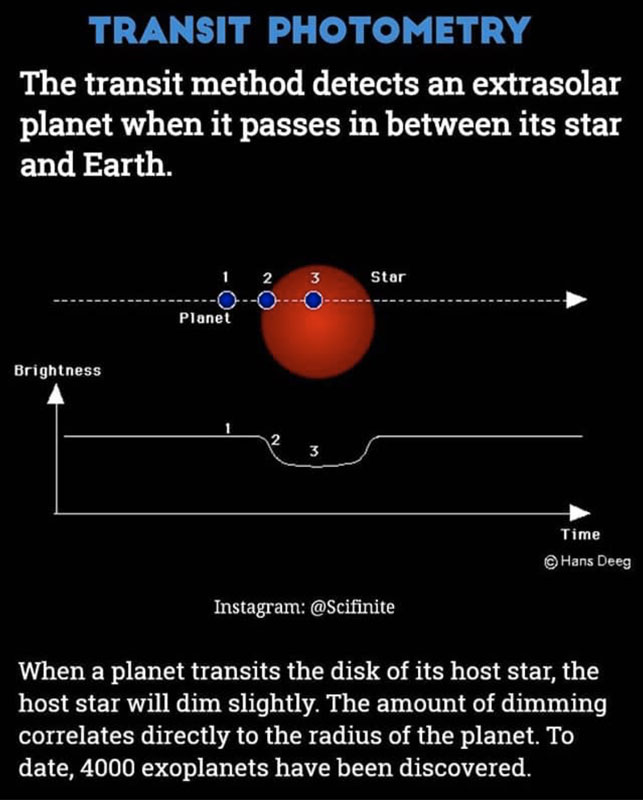
TESS = Transiting Exoplanet Survey Satellite
Le Transiting Exoplanet Survey Satellite (en français « Satellite de recensement des exoplanètes en transit »), plus connu par son acronyme TESS, est un petit télescope spatial consacré à la recherche d'exoplanètes lancé le 18 avril 2018. TESS a pour principal objectif de recenser de manière systématique les exoplanètes proches et de détecter plusieurs dizaines de planètes telluriques gravitant dans la zone habitable d'étoiles à la fois brillantes et proches.
Pour y parvenir, le télescope spatial, qui utilise la méthode de détection des transits, observera pratiquement tout le ciel en consacrant 27 jours à chaque secteur de la voute céleste. TESS observera des étoiles en moyenne 30 à 100 fois plus brillantes que celles étudiées par le télescope spatial Kepler, facilitant ainsi la détection de planètes de petite taille malgré le recours à des détecteurs beaucoup moins performants que ceux de Kepler. Les observations de TESS porteront en particulier sur des étoiles de type spectral G — catégorie à laquelle se rattache le Soleil — et K. Du fait de la durée des observations, les planètes détectées devraient avoir en moyenne une période orbitale d'une dizaine de jours. Les planètes détectées par TESS doivent être ensuite étudiées plus en détail par des instruments plus puissants comme le télescope spatial infrarouge James-Webb.
TESS est un engin spatial de petite taille (350 kilogrammes) qui emporte quatre caméras grand angle. Il circule sur une orbite terrestre haute de 13,7 jours, en résonance de moyen mouvement 2:1 avec la Lune, avec un apogée situé au-delà de l'orbite lunaire, choisie parce qu'elle permet de remplir les objectifs de la mission tout en restant dans l'enveloppe de coût du projet. Celui-ci a été sélectionné par la NASA en avril 2013 dans le cadre du programme Explorer de la NASA, dédié aux missions scientifiques à cout réduit (200 millions de dollars), et développé par le Massachusetts Institute of Technology. La mission primaire doit durer deux ans.
En février 2019, le satellite TESS, le tout nouveau chasseur d'exoplanètes de la Nasa, découvrait l'exoplanète GJ 357b. Cet astre orbite autour d'une étoile naine de type M d'environ 30% la taille et la masse du Soleil et 40% plus froide. Il est situé à 31 années-lumière de la Terre, dans la constellation de l'Hydre. En cherchant à confirmer l'existence de cette planète avec des observations au sol, les astrophysiciens ont déniché deux autres exoplanètes dans le même système.
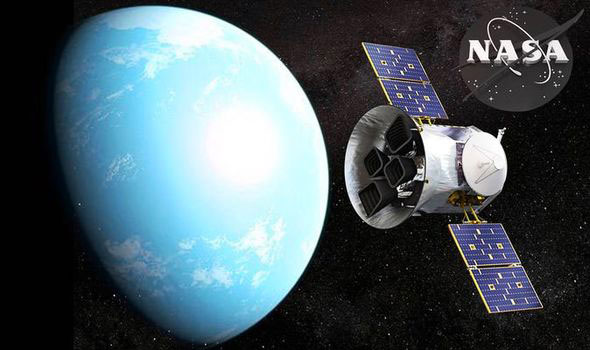
Le satellite TESS et une d'artiste de la planète GJ 357b.
The Transiting Exoplanet Survey Satellite (TESS) is a two-year survey that will discover exoplanets in orbit around bright stars.
NASA's exoplanet-hunting telescope, TESS has spotted an exoplanet 31 light years away called GJ 357 d. Now this discovery is rather remarkable because this star is supposed to have liquid water on it's surface. The study shows that GJ 357 d is in the habitable zone, where temperatures are just right.
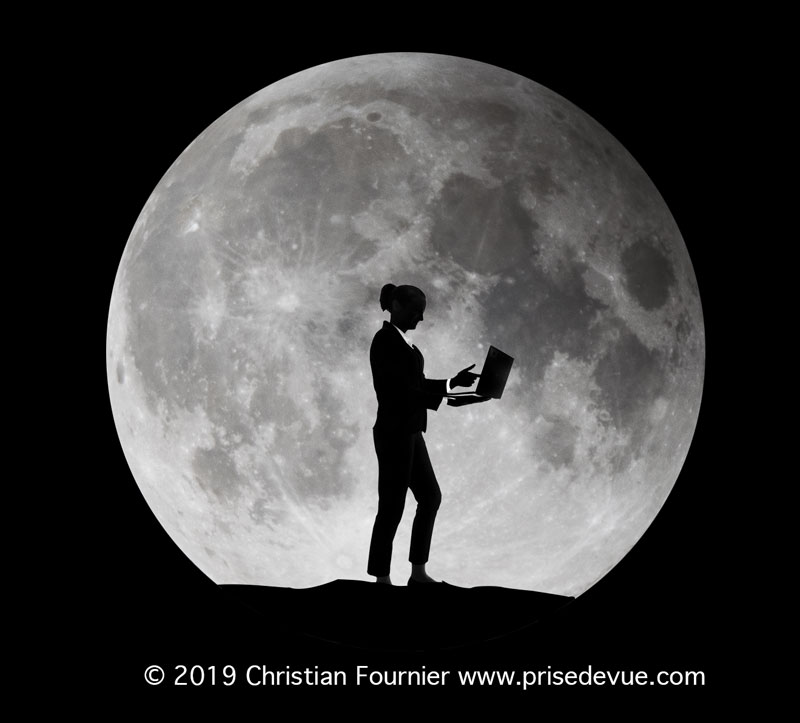
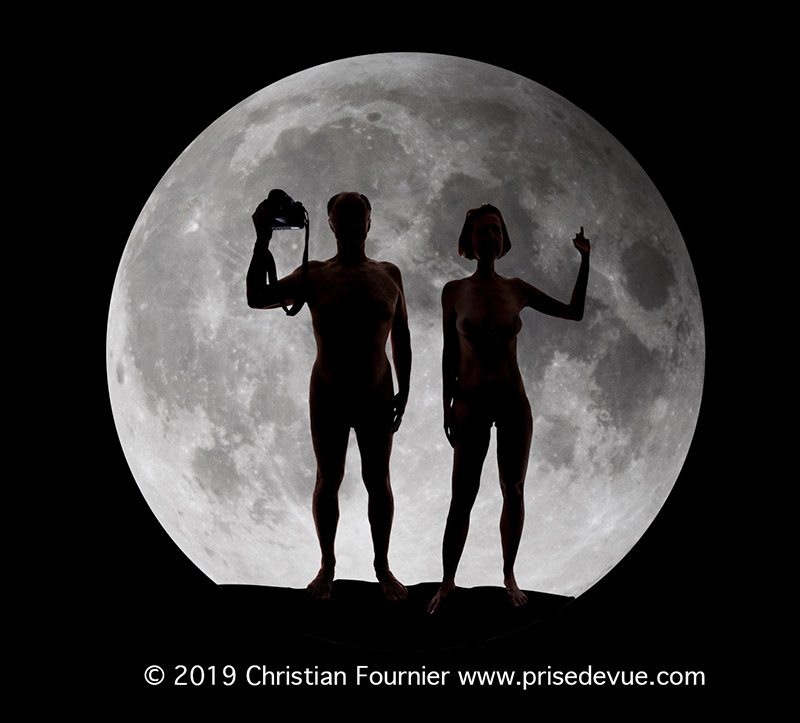
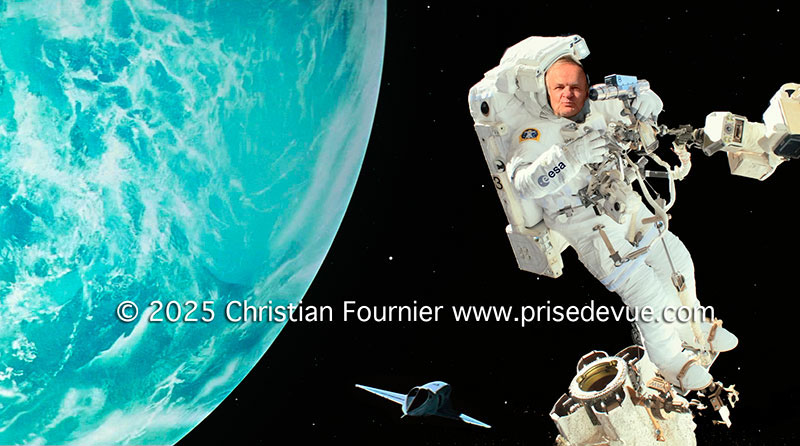
L'odyssée de l'espace 2025 : La NASA promet "des preuves irréfutables" d'une vie extraterrestre en 2025. De gauche à droite : Kepler 452b2015 l'exoplanète, le cowboy de l'espace Christian Fournier, la CFSS (Chris Fournier Space Station)
Photographié avec l'iPhone 36.
Le 27
septembre 2015 : La lune de sang
Prises de vue et montage intervallomètre : Christian Fournier.
Lieu : les locaux de L'AFA (Association Française d'Astronomie)
au Parc Montsouris à Paris.
Photos and timelapse by Christian Fournier in Parc Montsouris
near Paris.
Dans la nuit du 27 au 28 septembre 2015 a eu lieu une éclipse
lunaire exceptionnelle. Le satellite particulièrement près de
la Terre sera teinté de rouge et il disparaîtra totalement
pendant plusieurs minutes. Les éclipses lunaires totales ou
partielles peuvent sembler moins spectaculaires car plus
fréquentes que les éclipses solaires totales. Celle qui se
déroula dans la nuit du 28 septembre prochain a mérité
néanmoins d'avoir les yeux au ciel quelques minutes pour la
voir. En effet, il s'agit d'une "super-lune". L'astre
dont l'orbite réalise une ellipse autour de la Terre se trouva
très près de nous (363 104 km pour être précis) et a paru plus
grosse dans le ciel. Par ailleurs, l'alignement avec le soleil
donne à la lune une teinte écarlate particulière. Elle est
alors surnommée "Lune de Sang". C'est la conjonction
de ces deux phénomènes astronomiques qui rend l'événement
exceptionnel. Ce type d'éclipse se produit rarement et la
prochaine visible depuis la France aura lieu en 2033.
I used two Nikon boddies D600. One with a Nikkor 80-200mm F2.8
for the time-lapse and the other with a Sigma 500mm for the
close-ups. Both on tripods of course, equipped with Manfrotto
micrometric heads. Antivibration, mirror up, noise reduction,
remote triggering to avoid shake, drastic exposure bracketing,
raw format, lens correction with Lightroom, moon always in the
centre of the frame for better lens definition. The sky was
very clear and had been for the past two days without a single
cloud (rather rare for Paris), the air was crisp, the
visibility very sharp (very rare in Paris). During the day, we
had a special and unique carless day which reduces pollution (I
am not sure it contributed to this exceptional visibility
though). We were in a wooded small recreational small park in
Paris, with not to much light pollution (for Paris). Not many
stars were visible tough.
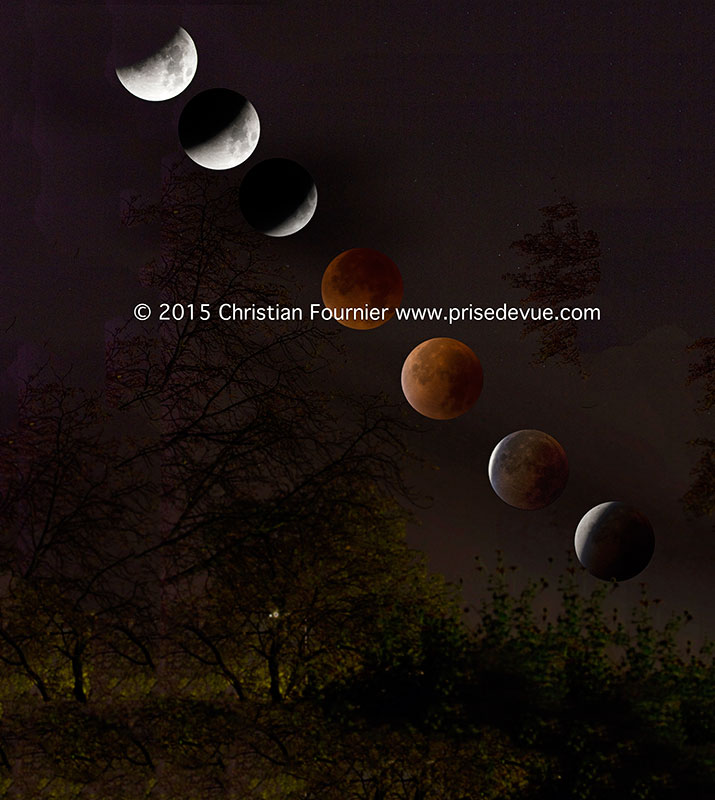
My photo is now on display at NASA, thanks to my longtime friend (1987) Shannon Templeton, who works on the TESS program, Transiting Exoplanet Survey Satellite, which searches for exoplanets. In February 2019, the satellite TESS, the new exoplanet hunter of NASA, discovered the exoplanet GJ 357b.
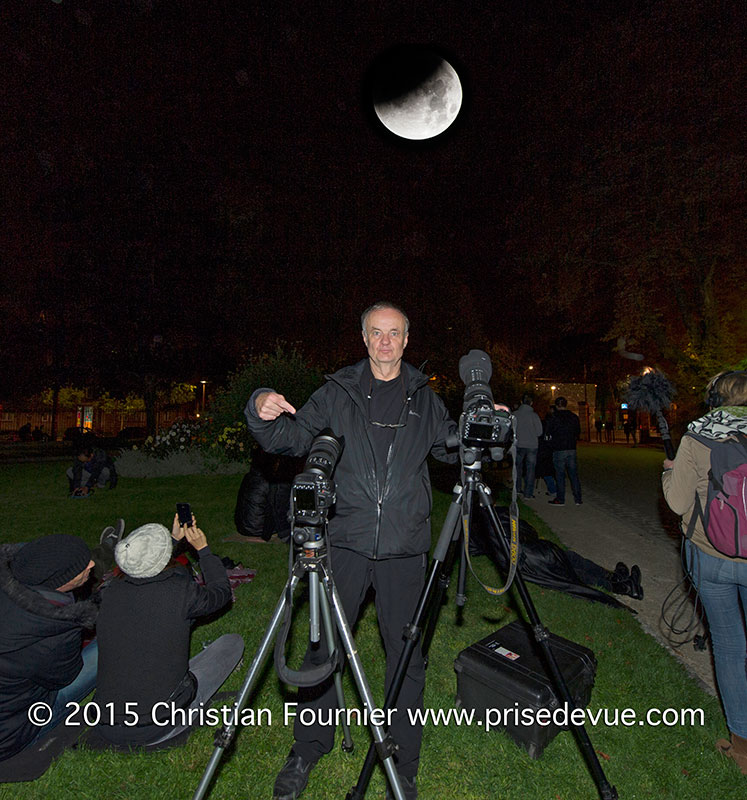
14 juillet 2019 : Éclipse partielle de la Lune, vue de Paris, dans ma cour, à Port Royal.
- 21h30 : la Lune se lève
- 22h00 : la Lune entre dans l'ombre de la Terre et commence à être grignotée
- 23h30 : la Lune est grignotée au maximum. 65 % de son disque est dans l'ombre de la terre
- 01H00 le matin : la Lune sort de l'ombre de la Terre. L'éclipse est finie.
Tout s’est déroulé comme prévu, comme toujours grâce aux astronomes. Pourtant la plupart des gens préfèrent l’astrologie à l’astronomie. Pourtant il est clair que l'astrologie et les horoscopes sont du baratin. Il y a une rubrique "horoscope" journalière dans tous les journaux du monde, mais jamais une rubrique journalière sur l'astronomie.
-"Ce n'est pas un signe de bonne santé mentale que d'être bien adapté à une société malade" : Jiddu Krishnamurti
Partial eclipse of the Moon, seen from Paris, in my courtyard, in Port Royal, on July 16, 2019.
- 9:30 pm: the Moon rises
- 22:00: the Moon enters the shadow of the Earth and begins to be nibbled
- 23:30: the Moon is nibbled to the maximum. 65% of his disk is in the shadow of the
- 01H00 in the morning: the Moon comes out of the shadow of the Earth. The eclipse is over.
Everything went as planned as always thanks to astronomers. Yet most people prefer astrology to astronomy. Yet it is clear that astrology and its horoscopes are bullshit. Yet, there is a daily "horoscope" section in every newspaper in the world, but never a daily section on astronomy.
- "It is not a sign of good mental health to be well adapted to a sick society": Jiddu Krishnamurti.






La soucoupe volante est un lampadaire éteint

Hello Christian!
Those are gorgeous pictures of the Moon, I love how you included the night version of the "UFO" and then the day version showing it is a lamp. That is wonderful!
I have stopped using Facebook, it was taking up too much of my time. I also think it is a little bit awful and actively screwed up the elections for the US helping put Trump in office. But it does have its good side, such as getting to see your pictures, and I really miss that. So I may start using it again, who knows? I am so happy you emailed me when you didn't see me on Facebook. Thank you for doing that!
I am involved with a very exciting project now which is taking up my time - NASA's TESS planet hunter space telescope. The observatory I work with got accepted into their "follow up" program which means I'm part of the group of astronomers who get to see the data first. The TESS cameras have huge pixels that can have more than one star in each pixel, so when an exoplanet crosses in front of its star (from our point of view), there is a small dip in the light. The TESS cameras will detect the small dimming which triggers an alert that there may be an exoplanet somewhere in the sky area covered by the huge pixel. We get a list of those coordinates in the sky and then it's our job to follow up using our ground based telescope to see which star is dimming in brightness. I hope I have explained it well, it is so exciting to be involved with this work! What could be more fun than finding planets outside our solar system?
This gives a good overview of what TESS does: https://www.nasa.gov/content/about-tess
The Transiting Exoplanet Survey Satellite (TESS) is the next step in the search for planets outside of our solar system, including those that could support life. The mission will find exoplanets that periodically block part of the light from their host stars, events called transits. TESS will survey 200,000 of the brightest stars near the sun to search for transiting exoplanets. TESS launched on April 18, 2018, aboard a SpaceX Falcon 9 rocket.
TESS scientists expect the mission will catalog thousands of planet candidates and vastly increase the current number of known exoplanets. Of these, approximately 300 are expected to be Earth-sized and super-Earth-sized exoplanets, which are worlds no larger than twice the size of Earth. TESS will find the most promising exoplanets orbiting our nearest and brightest stars, giving future researchers a rich set of new targets for more comprehensive follow-up studies.
And here is more about the Follow Up program if you want to see examples of the data. I know you would love the math. https://heasarc.gsfc.nasa.gov/docs/tess/followup.html
I hope you are doing well, it is always wonderful to hear from you.
Shannon

TESS = Transiting Exoplanet Survey Satellite
Le Transiting Exoplanet Survey Satellite (en français « Satellite de recensement des exoplanètes en transit »), plus connu par son acronyme TESS, est un petit télescope spatial consacré à la recherche d'exoplanètes lancé le 18 avril 2018. TESS a pour principal objectif de recenser de manière systématique les exoplanètes proches et de détecter plusieurs dizaines de planètes telluriques gravitant dans la zone habitable d'étoiles à la fois brillantes et proches.
Pour y parvenir, le télescope spatial, qui utilise la méthode de détection des transits, observera pratiquement tout le ciel en consacrant 27 jours à chaque secteur de la voute céleste. TESS observera des étoiles en moyenne 30 à 100 fois plus brillantes que celles étudiées par le télescope spatial Kepler, facilitant ainsi la détection de planètes de petite taille malgré le recours à des détecteurs beaucoup moins performants que ceux de Kepler. Les observations de TESS porteront en particulier sur des étoiles de type spectral G — catégorie à laquelle se rattache le Soleil — et K. Du fait de la durée des observations, les planètes détectées devraient avoir en moyenne une période orbitale d'une dizaine de jours. Les planètes détectées par TESS doivent être ensuite étudiées plus en détail par des instruments plus puissants comme le télescope spatial infrarouge James-Webb.
TESS est un engin spatial de petite taille (350 kilogrammes) qui emporte quatre caméras grand angle. Il circule sur une orbite terrestre haute de 13,7 jours, en résonance de moyen mouvement 2:1 avec la Lune, avec un apogée situé au-delà de l'orbite lunaire, choisie parce qu'elle permet de remplir les objectifs de la mission tout en restant dans l'enveloppe de coût du projet. Celui-ci a été sélectionné par la NASA en avril 2013 dans le cadre du programme Explorer de la NASA, dédié aux missions scientifiques à cout réduit (200 millions de dollars), et développé par le Massachusetts Institute of Technology. La mission primaire doit durer deux ans.
En février 2019, le satellite TESS, le tout nouveau chasseur d'exoplanètes de la Nasa, découvrait l'exoplanète GJ 357b. Cet astre orbite autour d'une étoile naine de type M d'environ 30% la taille et la masse du Soleil et 40% plus froide. Il est situé à 31 années-lumière de la Terre, dans la constellation de l'Hydre. En cherchant à confirmer l'existence de cette planète avec des observations au sol, les astrophysiciens ont déniché deux autres exoplanètes dans le même système.

Le satellite TESS et une d'artiste de la planète GJ 357b.
The Transiting Exoplanet Survey Satellite (TESS) is a two-year survey that will discover exoplanets in orbit around bright stars.




Space Odyssey
2025: NASA promises 'definitive evidence' of alien life by 2025.
Space Odyssey 2025: NASA promises 'definitive evidence' of alien life by 2025.
Left to right: Kepler 452b2015, space cowboy Chris Fournier, the CFSS (Chris
Fournier Space Station).
Photographed with an iPhone 36.
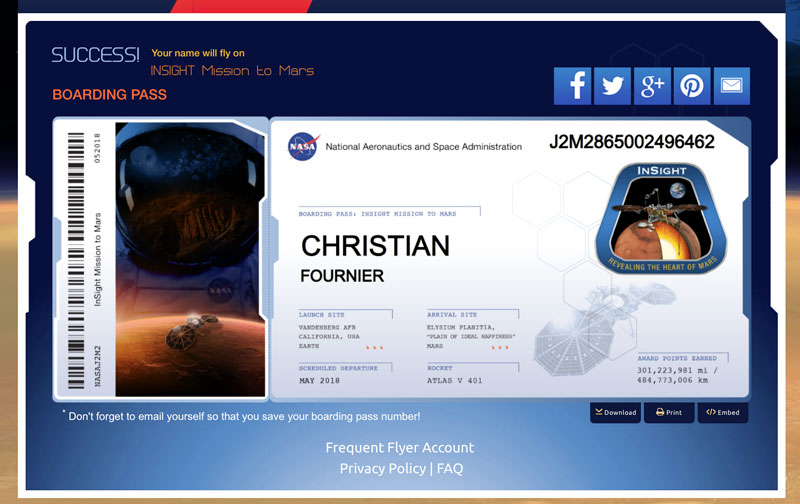
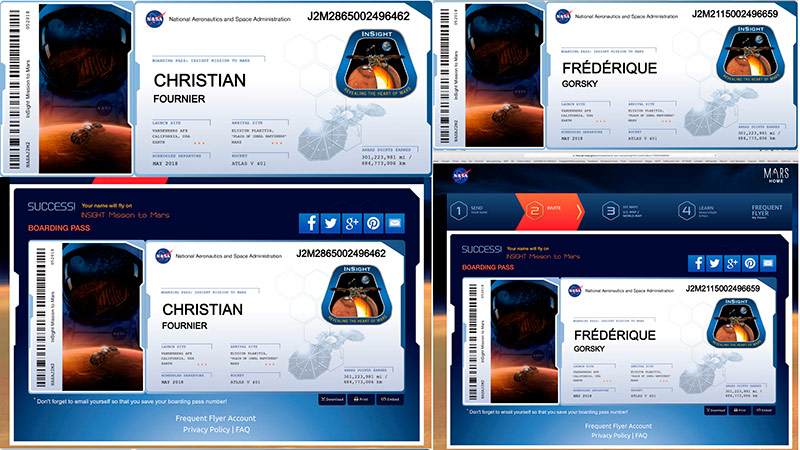
Je n'a pas pu assister au décollage de la fusée Atlas V 401, en route vers Elysium Planitiala sur la planète Mars, en Californie en mai 2018.
My name is engraved on an electronic chip filed on Mars by Insight!
Thanks to Shannon Templeton for that.
InSight (acronyme de l'anglais Interior Exploration using Seismic Investigations, Geodesy and Heat Transport ; en français : Exploration interne par les sondages sismiques, la géodésie et les flux thermiques) est une mission d'exploration de la planète Mars développée par l'agence spatiale américaine, la NASA qui a décollé le 5 mai 2018 et a atterri à la surface de la planète le 26 novembre 2018.
C'est la première mission entièrement consacrée à l'étude de la structure interne de cette planète. Pour y parvenir, elle emporte deux instruments scientifiques : le sismomètre SEIS et HP3, instrument de mesure des flux de chaleur en provenance du cœur de la planète. L'objectif scientifique principal de la mission est de disposer d'une meilleure connaissance de la structure interne de la planète, dont les caractéristiques sont mal connues, dans le but de reconstituer l'histoire de Mars. Les données collectées permettront également d'améliorer les modèles de formation et d'évolution des planètes rocheuses du système solaire — Mercure, Vénus, la Terre, Mars — ainsi que de la Lune.
Lorsque la mission InSight est sélectionnée en 2012, dans le cadre du programme Discovery de la NASA, elle constitue l'aboutissement de plusieurs projets proposés sans succès au cours des deux décennies qui ont précédé. Le programme Discovery regroupe des projets spatiaux américains caractérisés par un coût modéré et un cycle de développement court. Pour rentrer dans cette contrainte budgétaire, la mission repose sur l'envoi d'une station au sol unique contrairement aux projets qui l'avaient précédé. La sonde spatiale réutilise l'architecture de la mission Phoenix, qui s'était posée en 2007 dans la région polaire de Mars. C'est un engin de relativement petite taille (moins de 700 kilogrammes, au lancement). La charge utile est fournie par des partenaires européens. L'instrument principal, le sismomètre SEIS est conçu par l'Institut de physique du globe de Paris et fourni sous maitrise d’œuvre de l'agence spatiale française (CNES), tandis que HP3 est développé par l'Allemagne.
Un problème de mise au point sur l'instrument SEIS repousse le lancement de la mission, prévu initialement en 2016, à la fenêtre de lancement suivante vers Mars en 2018. Insight se pose à la surface de Mars le 26 novembre 2018 dans une région de plaine baptisée Elysium Planitia, située près de l'équateur de cette planète. La phase d'étude scientifique doit durer deux années terrestres.
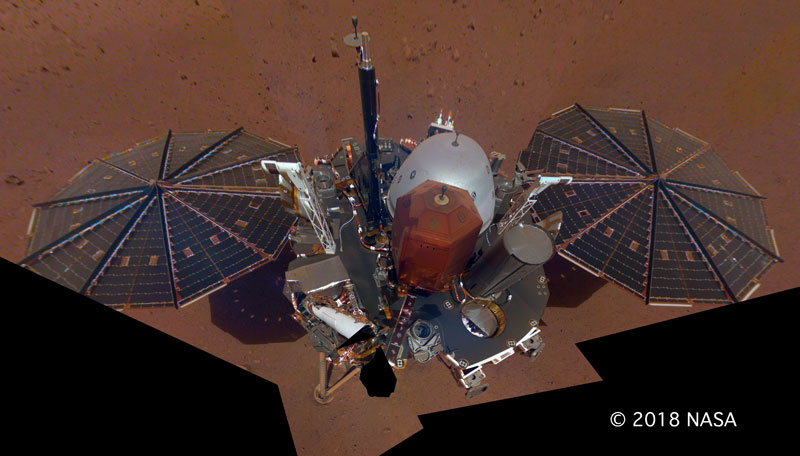
This is NASA InSight's first full selfie on Mars. It displays the lander's solar panels and deck. On top of the deck are its science instruments, weather sensor booms and UHF antenna. The selfie was taken on Dec. 6, 2018 (Sol 10).
The selfie is made up of 11 images which were taken by its Instrument Deployment Camera, located on the elbow of its robotic arm. Those images are then stitched together into a mosaic.
JPL manages InSight for NASA's Science Mission Directorate. InSight is part of NASA's Discovery Program, managed by the agency's Marshall Space Flight Center in Huntsville, Alabama. Lockheed Martin Space in Denver built the InSight spacecraft, including its cruise stage and lander, and supports spacecraft operations for the mission.
A number of European partners, including France's Centre National d'Études Spatiales (CNES) and the German Aerospace Center (DLR), are supporting the InSight mission. CNES and the Institut de Physique du Globe de Paris (IPGP) provided the Seismic Experiment for Interior Structure (SEIS) instrument, with significant contributions from the Max Planck Institute for Solar System Research (MPS) in Germany, the Swiss Institute of Technology (ETH) in Switzerland, Imperial College and Oxford University in the United Kingdom, and JPL. DLR provided the Heat Flow and Physical Properties Package (HP3) instrument, with significant contributions from the Space Research Center (CBK) of the Polish Academy of Sciences and Astronika in Poland. Spain's Centro de Astrobiología (CAB) supplied the wind sensors.
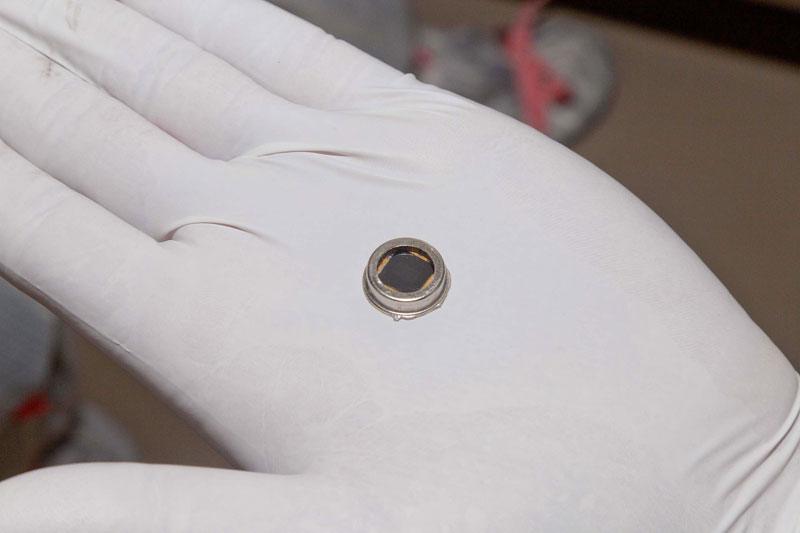
Une des puces d'InSight contenant les noms des personnes ayant participé à la campagne
dont Frédérique Gorsky et moi-même.
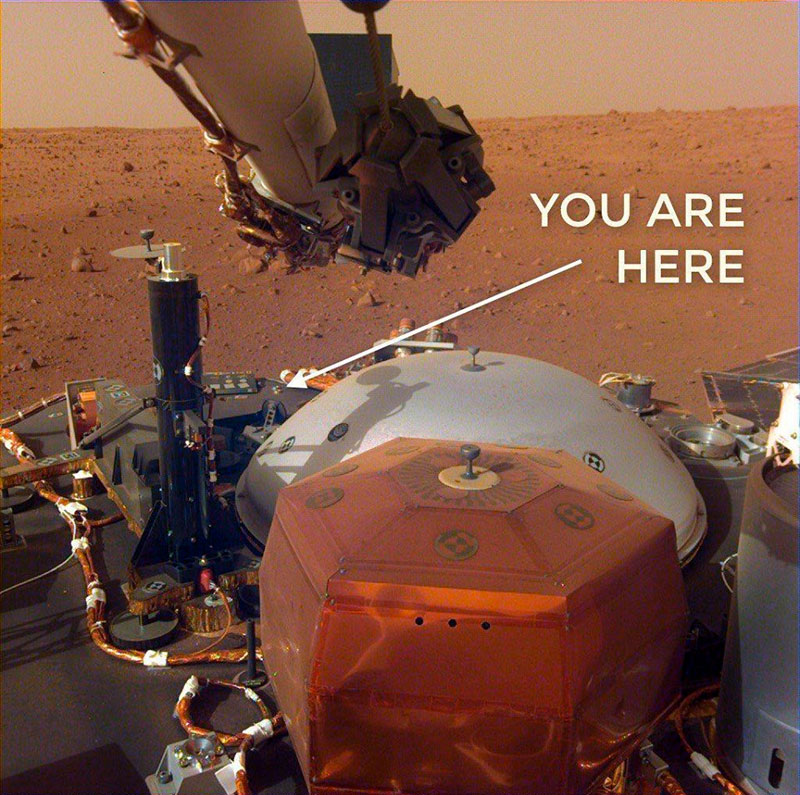
Voici où nos noms sont écrits, dans la petite capsule. Ils devraient y resté des millions d'années !
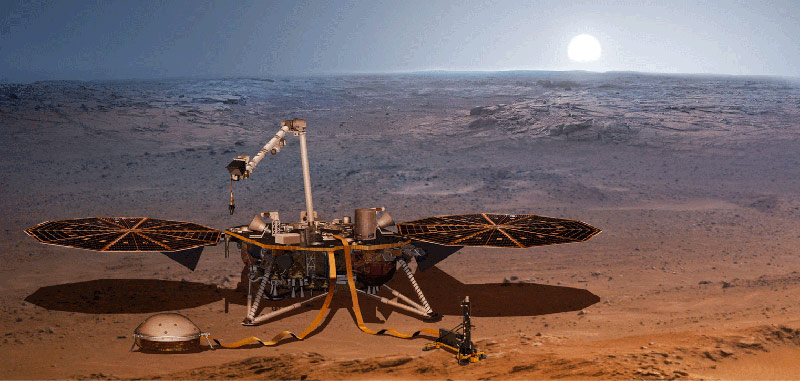
Insight à Elysium Planitia
Le 28 sept 2021
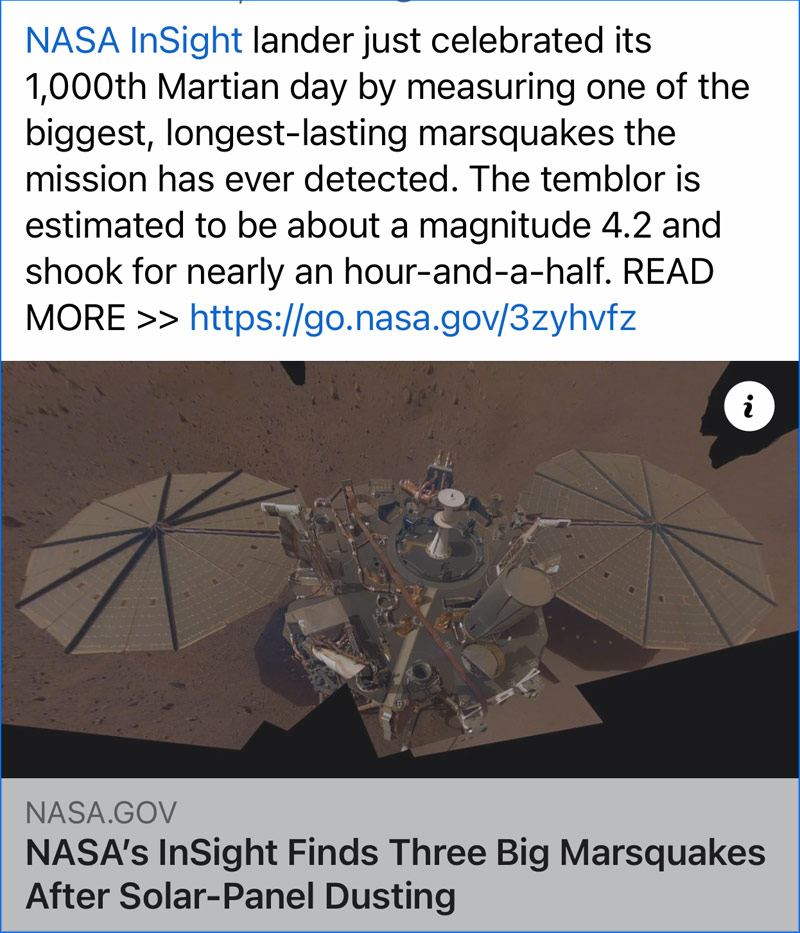
***************************************

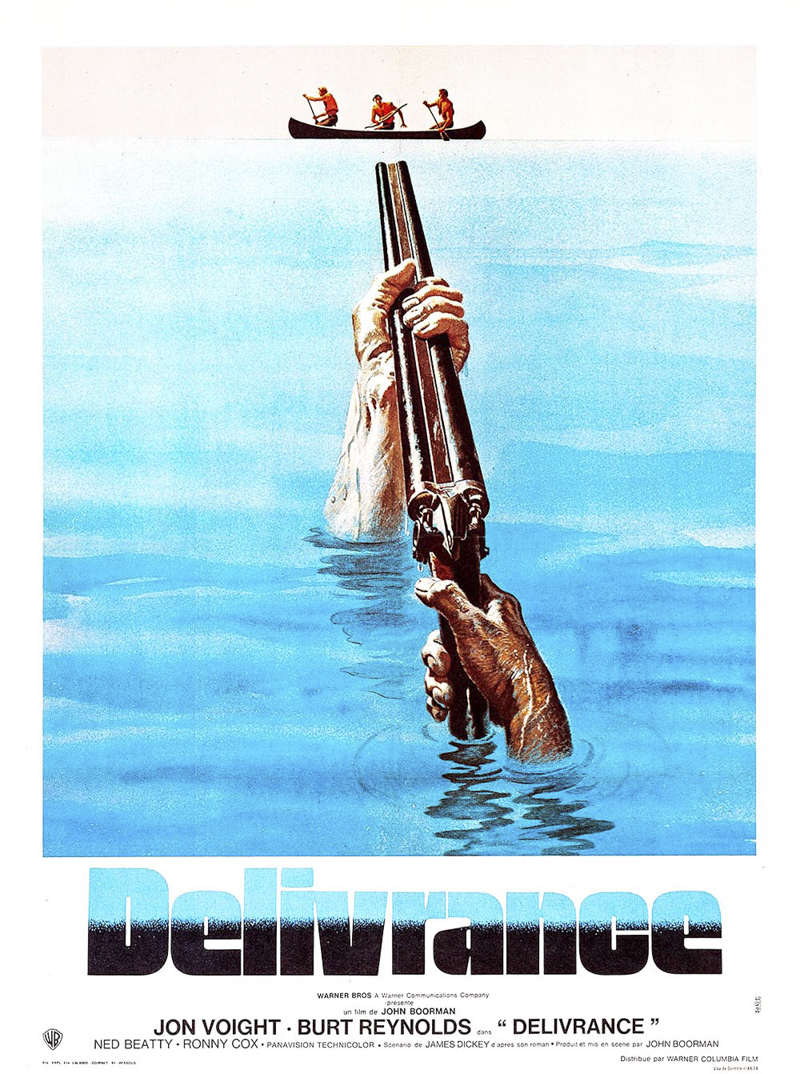
Some LPs of my youth.
 
J'ai eu l'immense plaisir de photographier Le Palais de la Musique en 2016 à Barcelone

|


